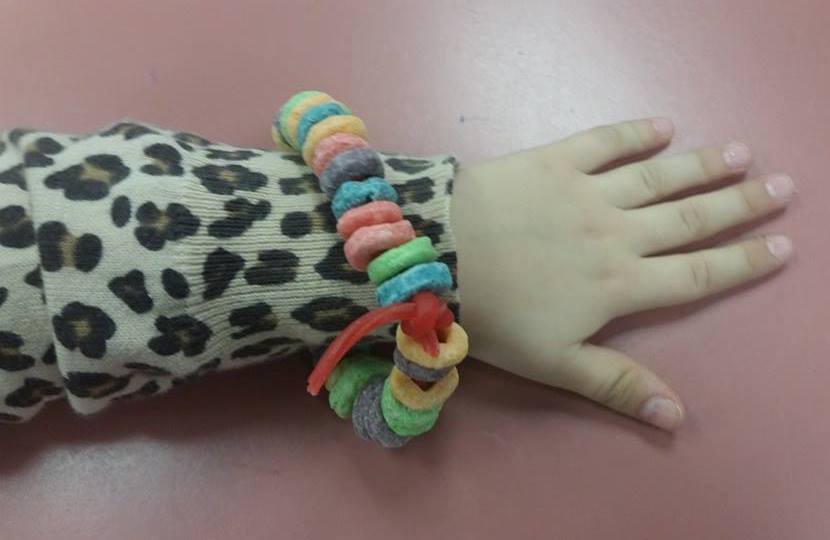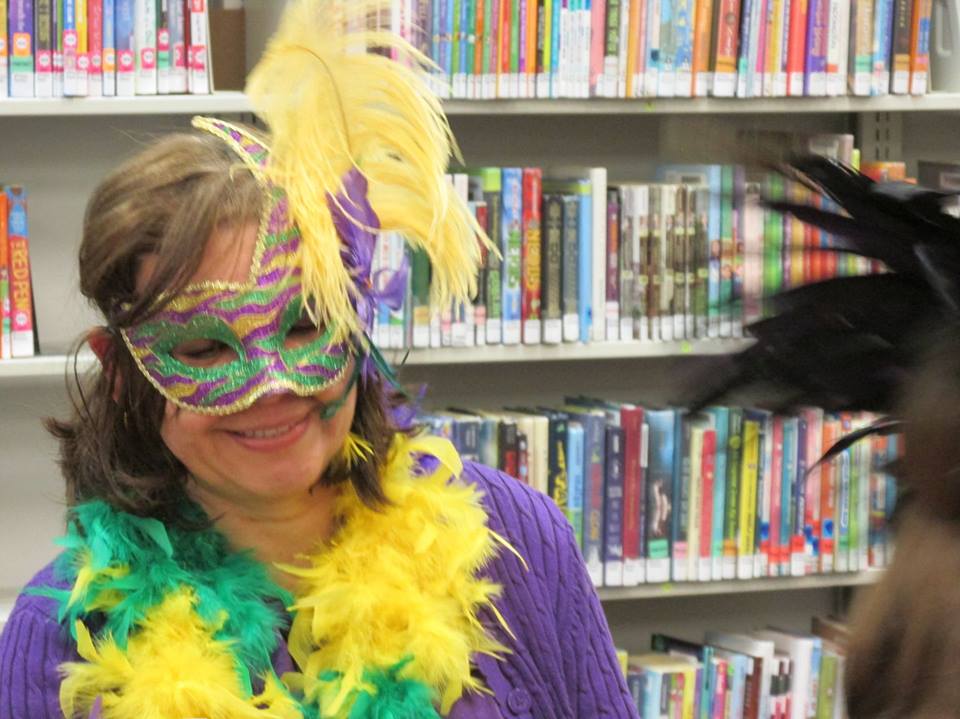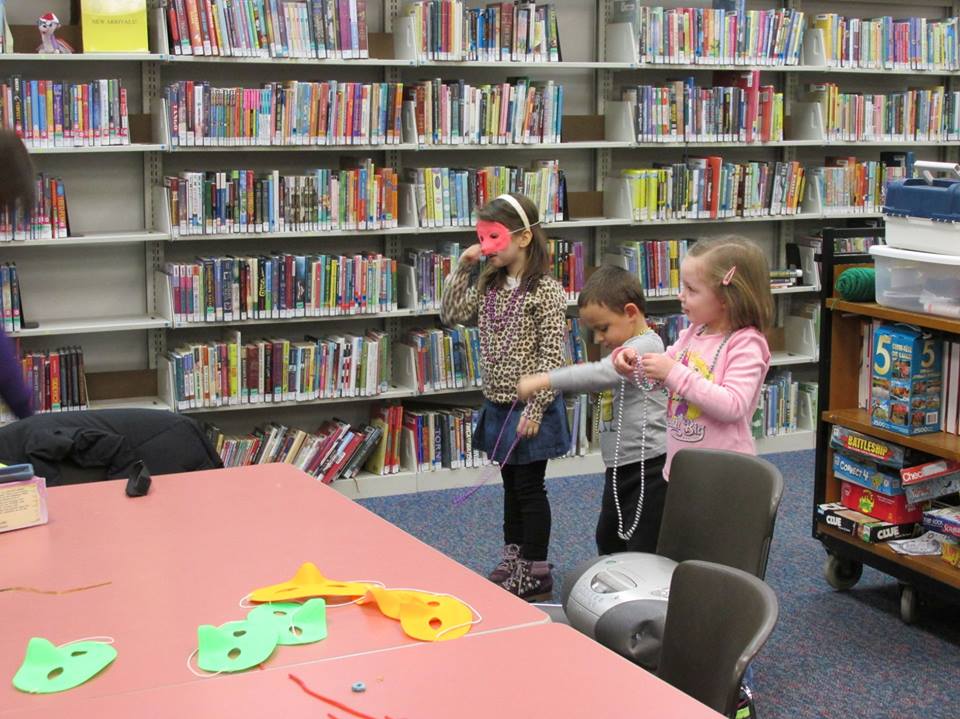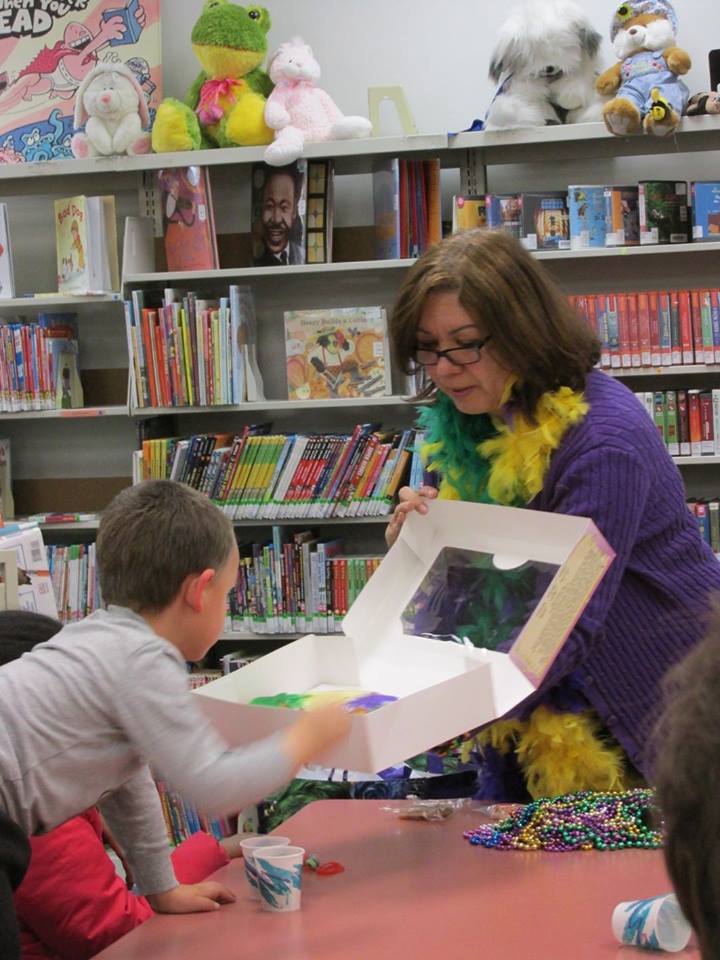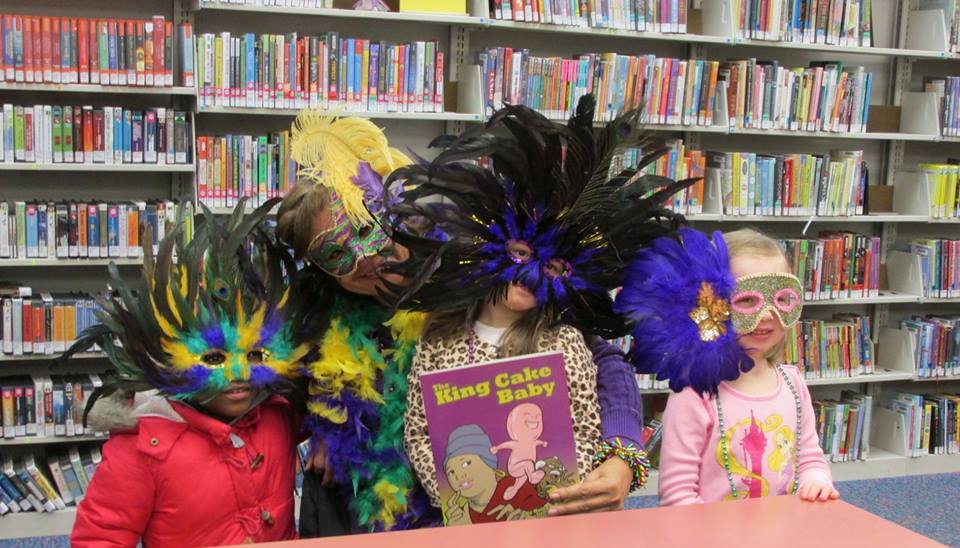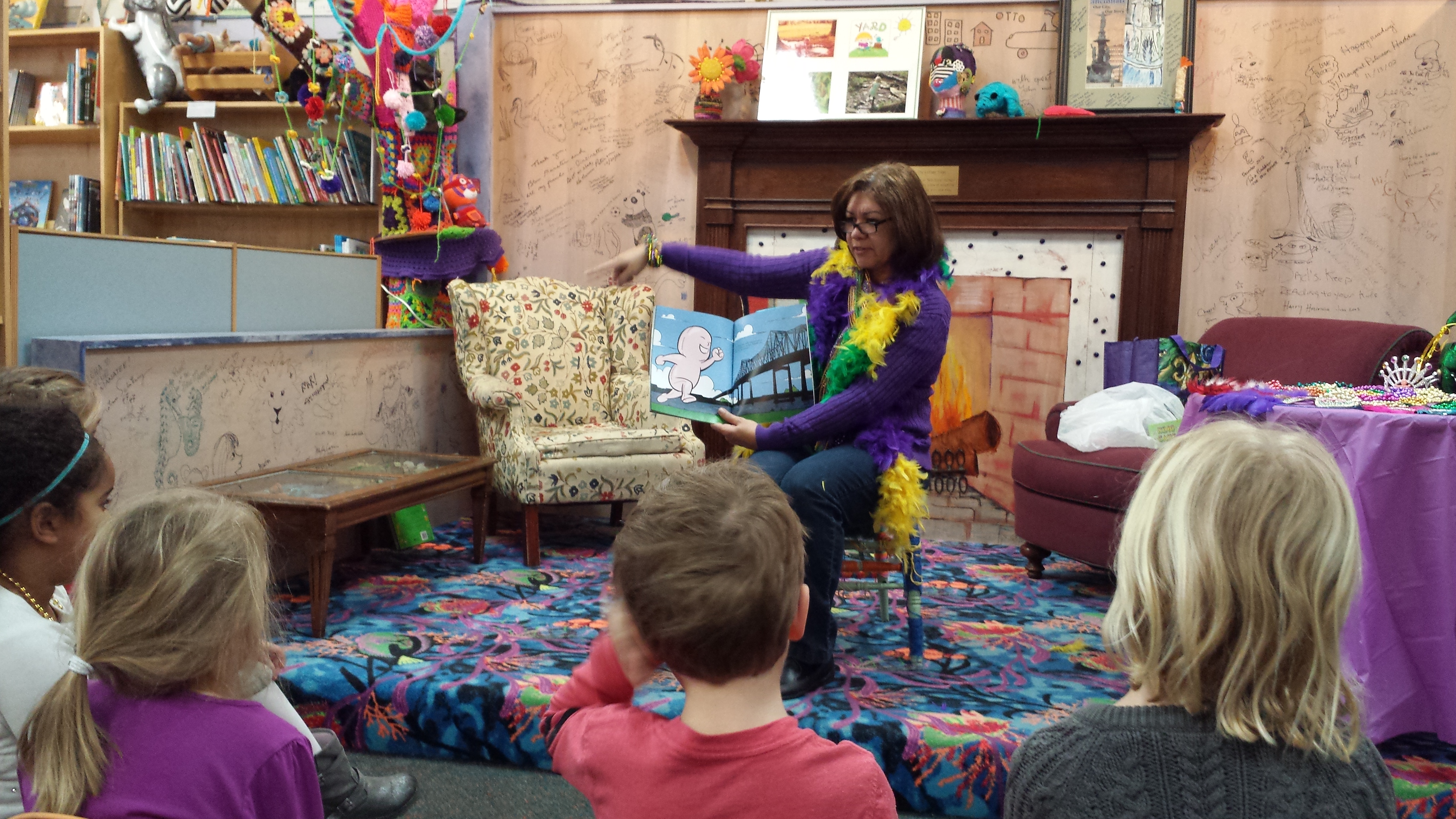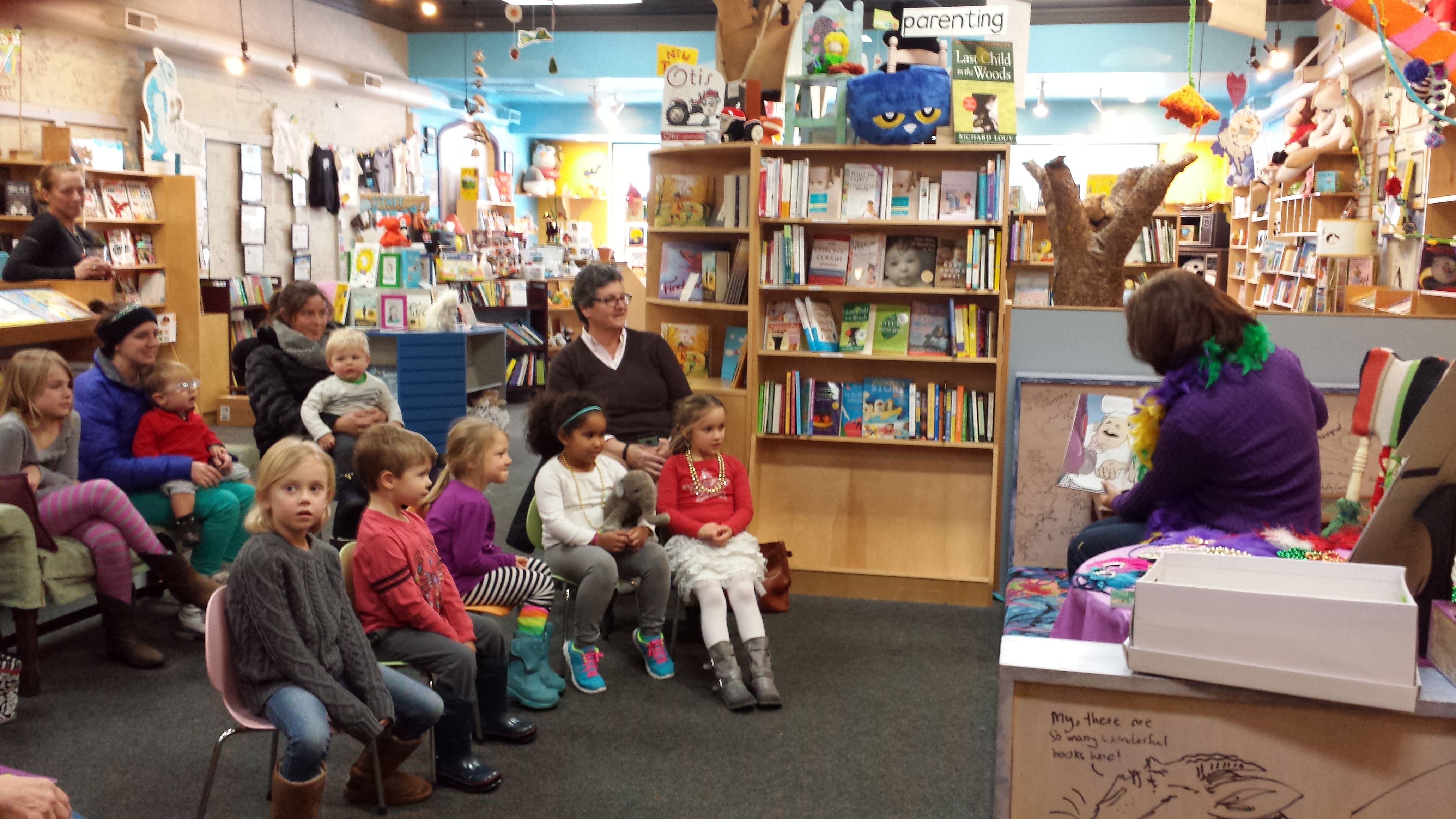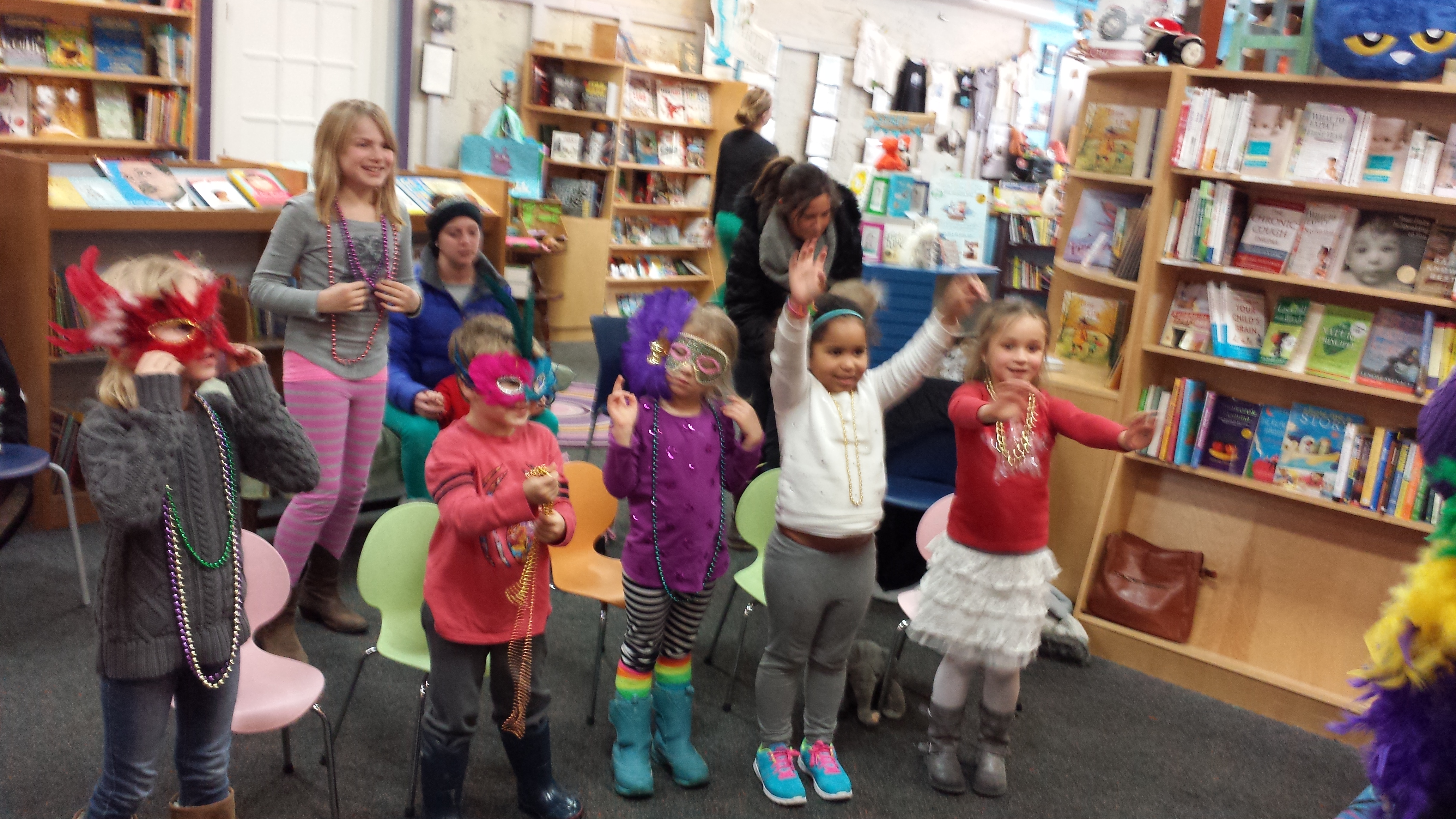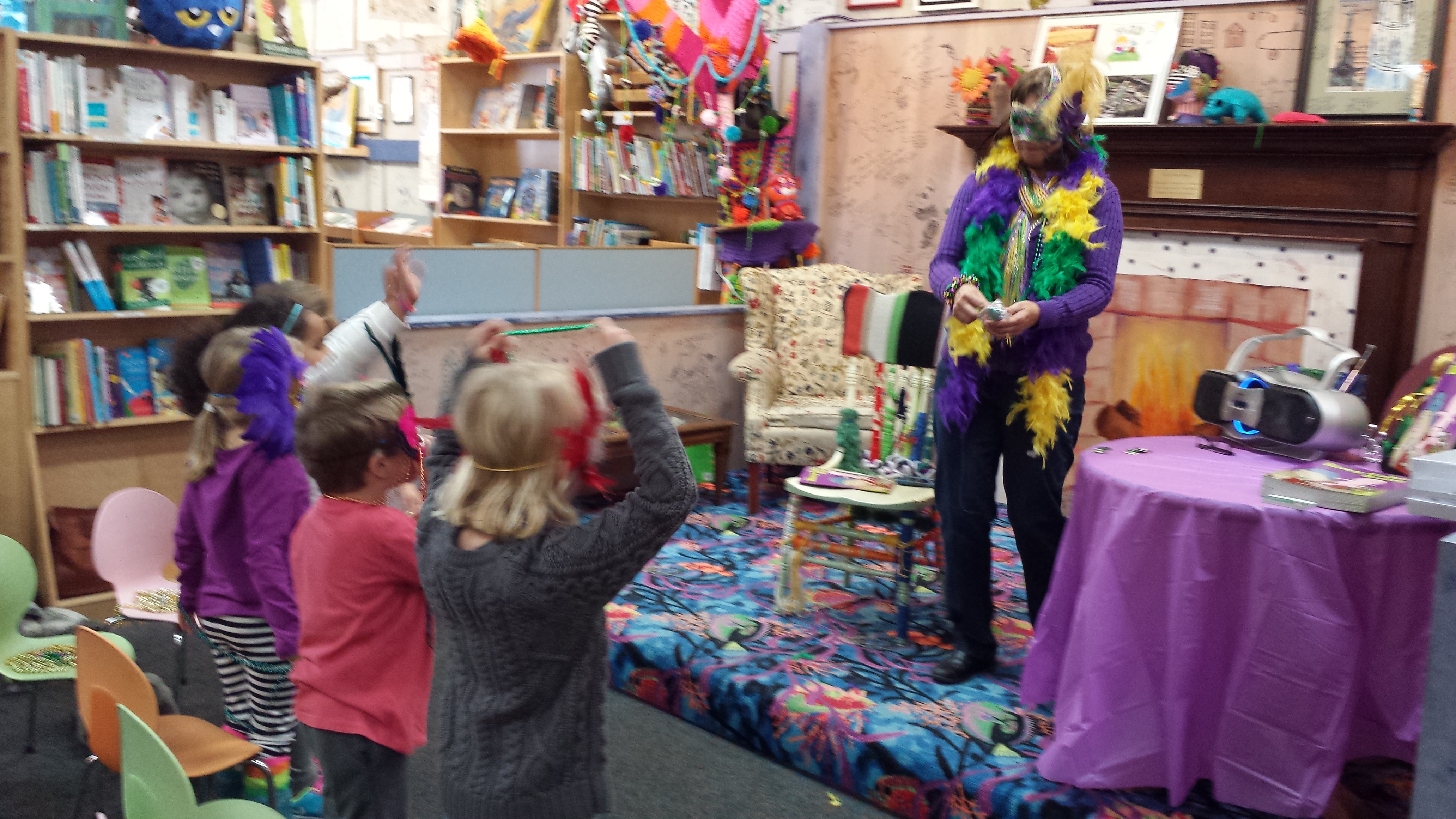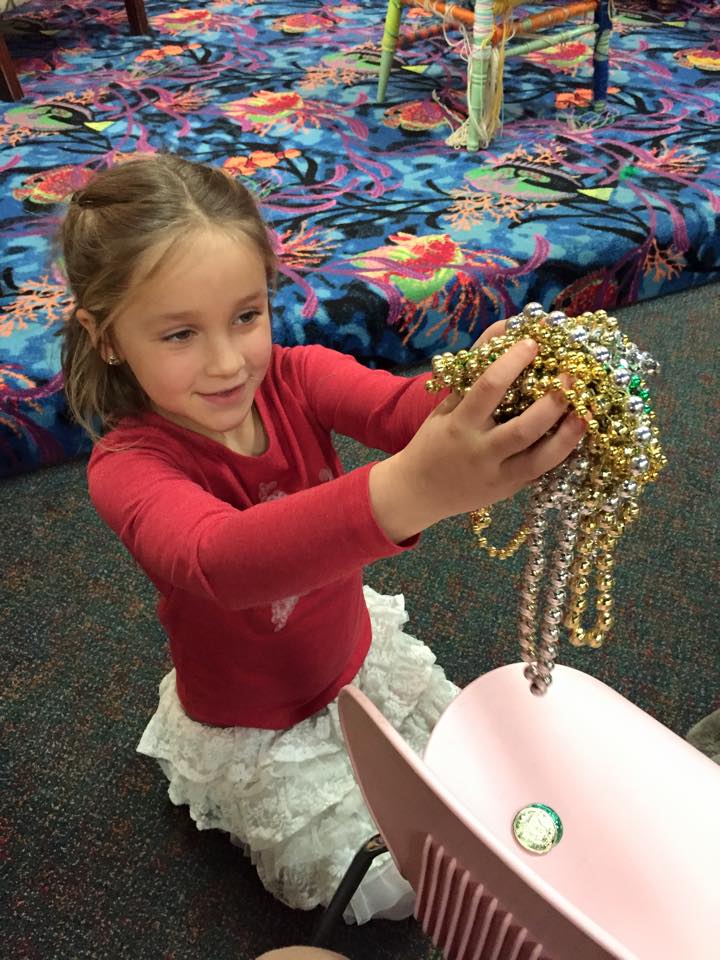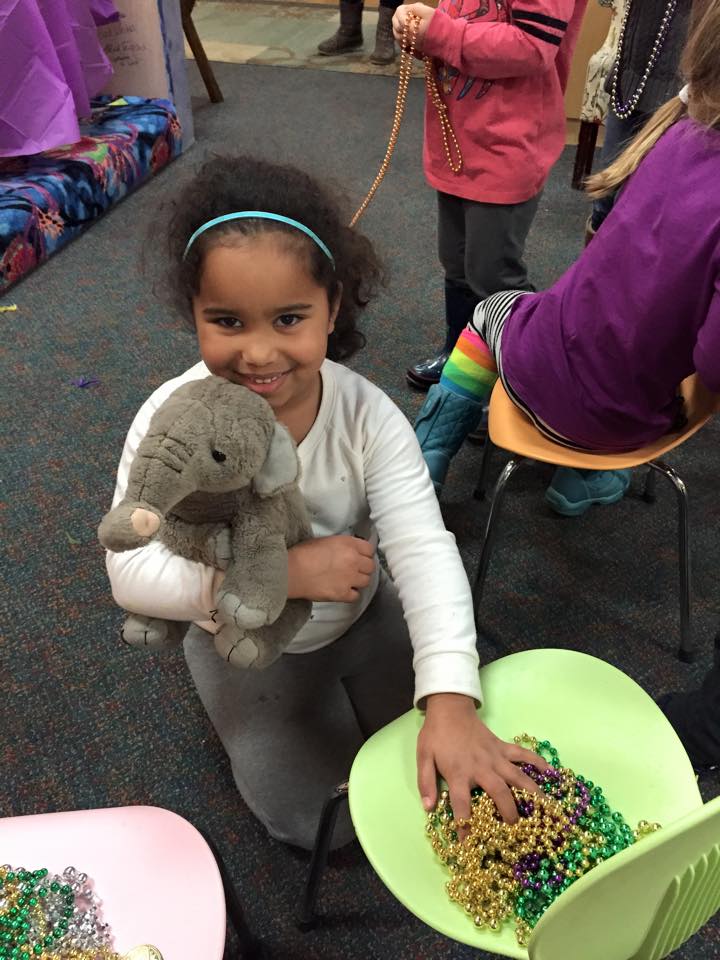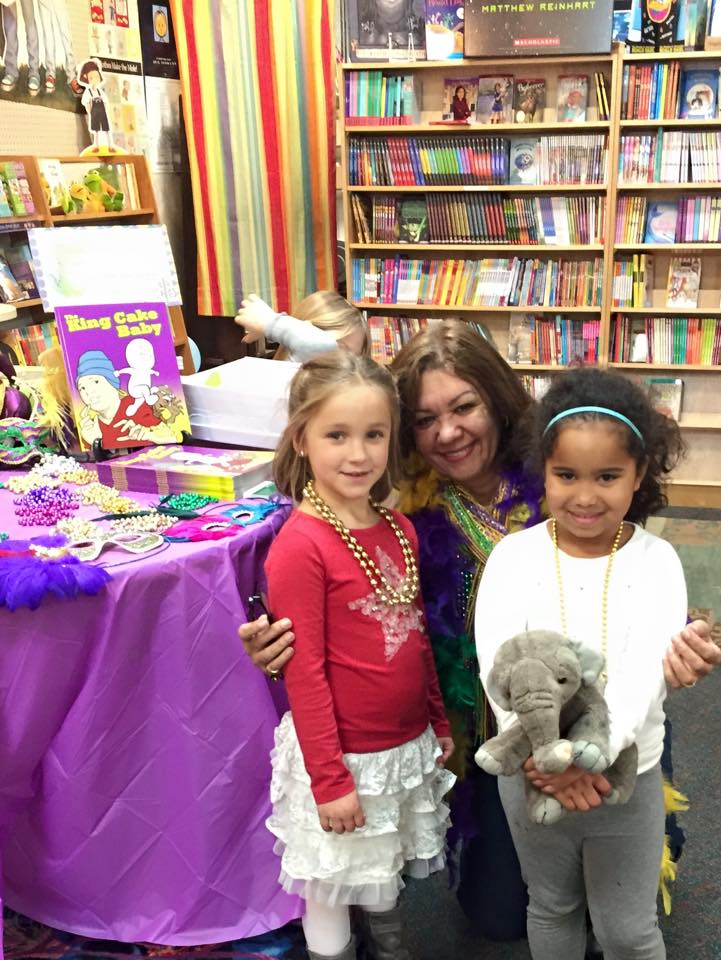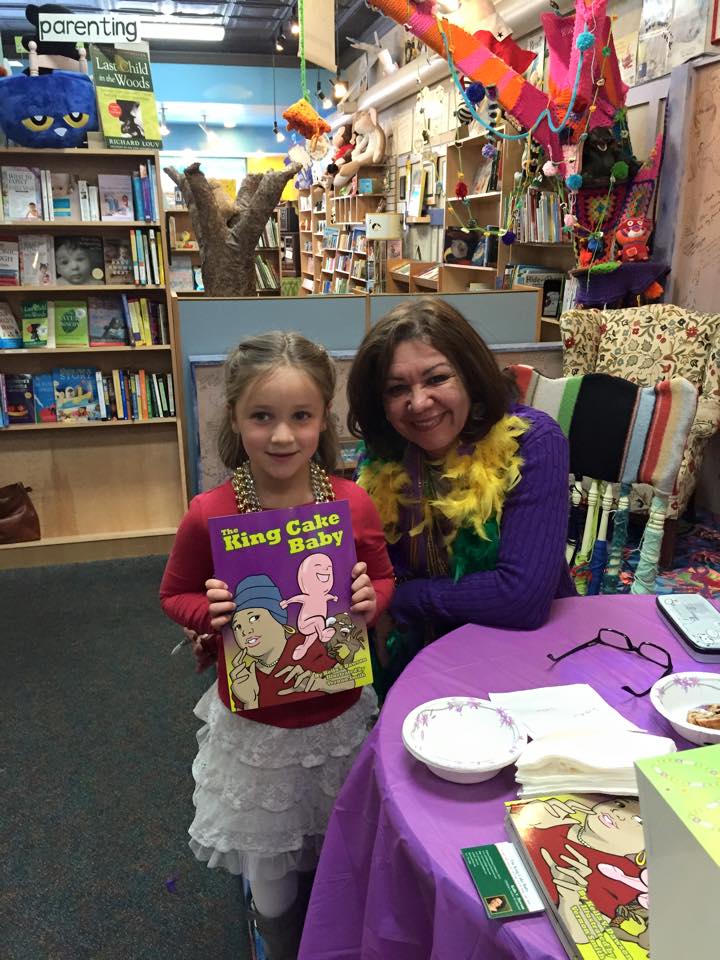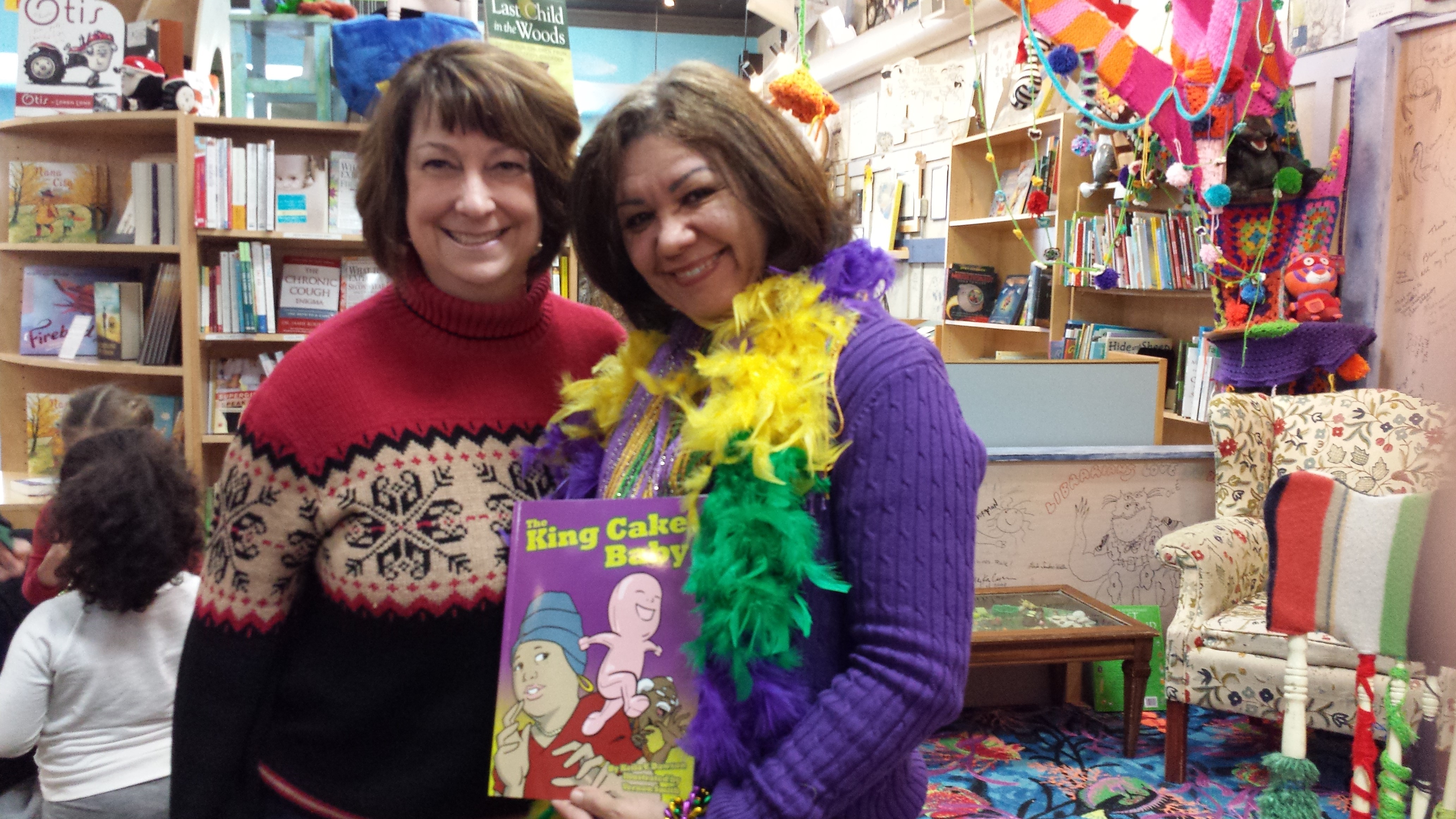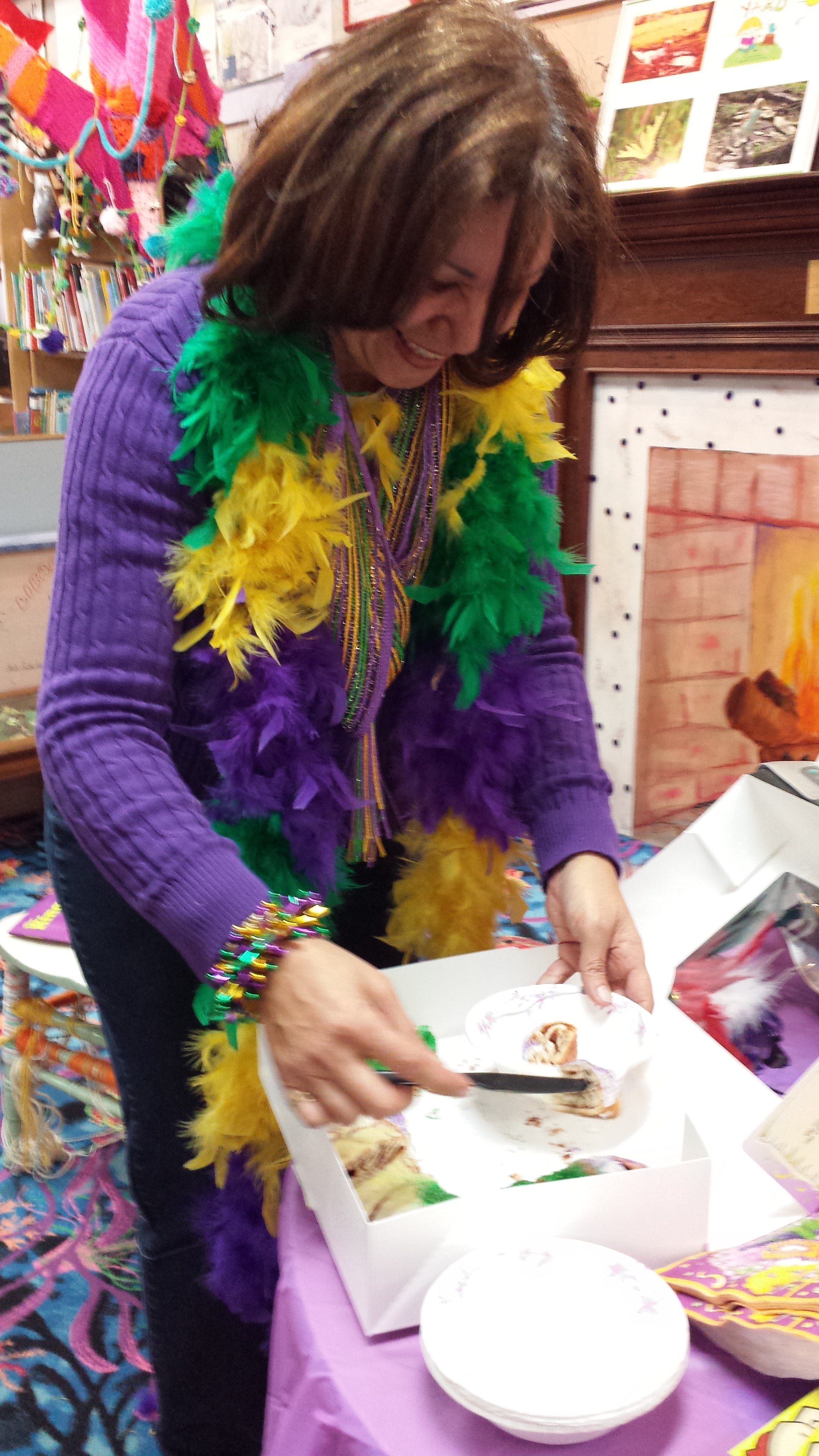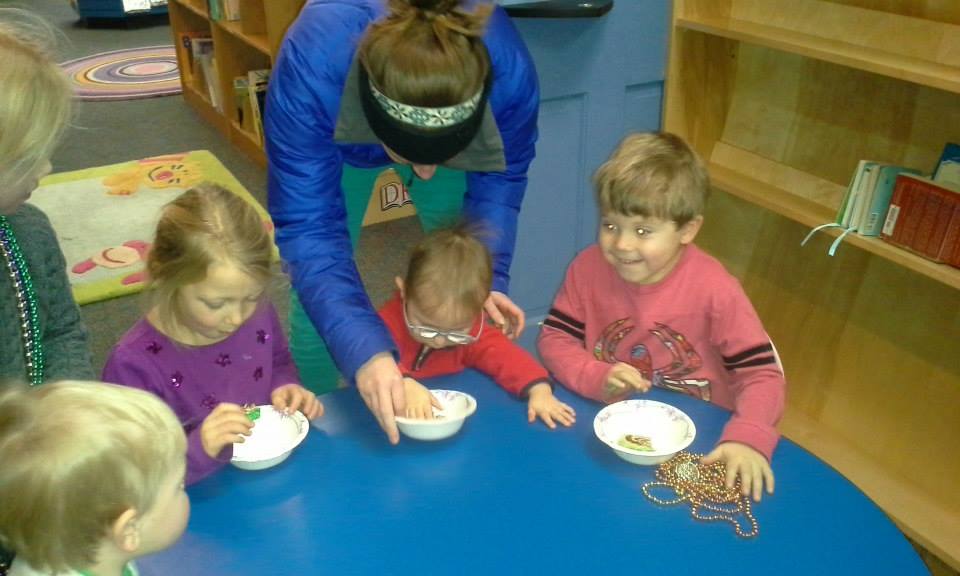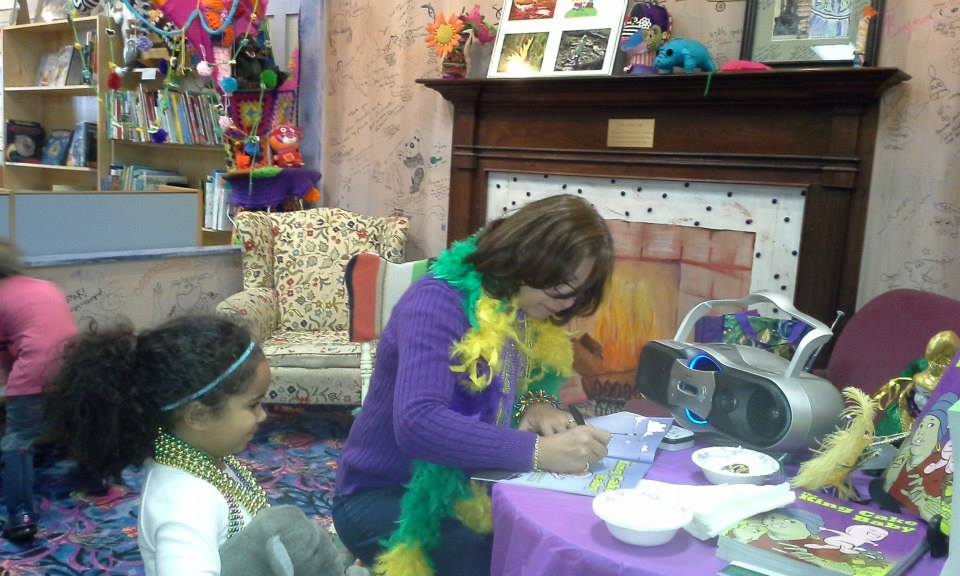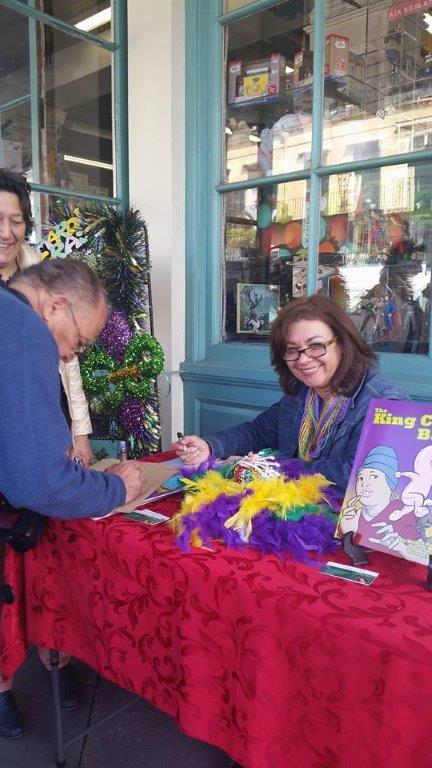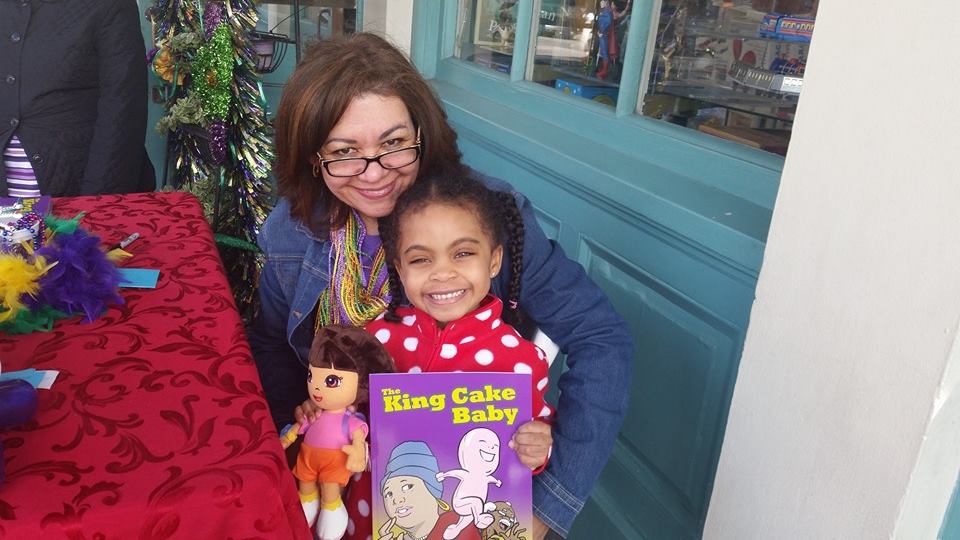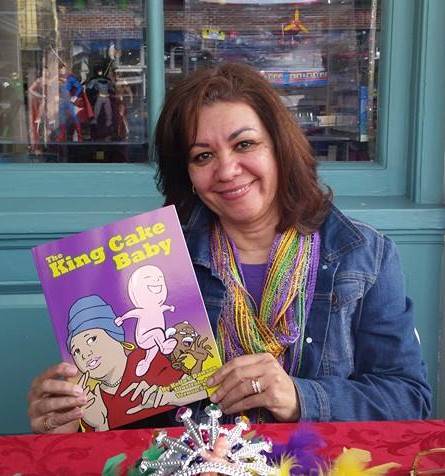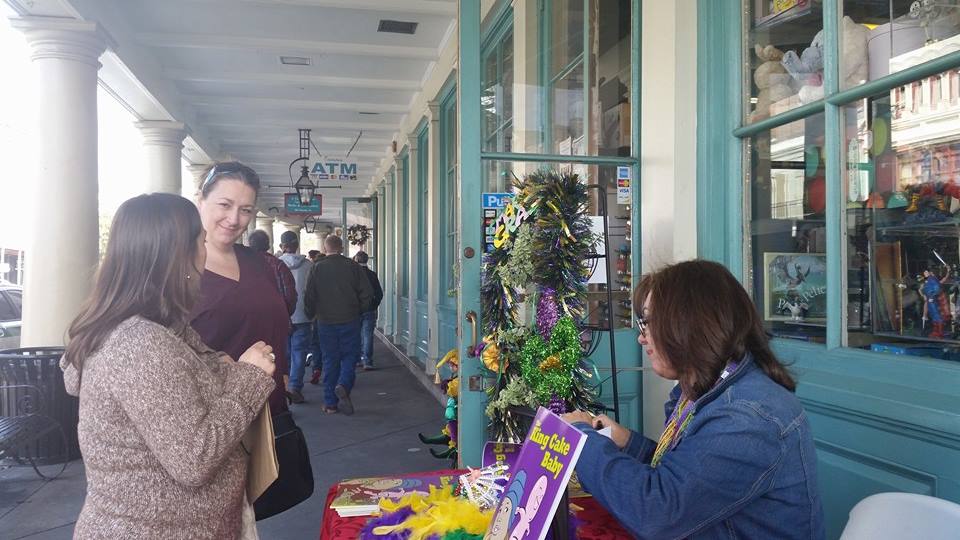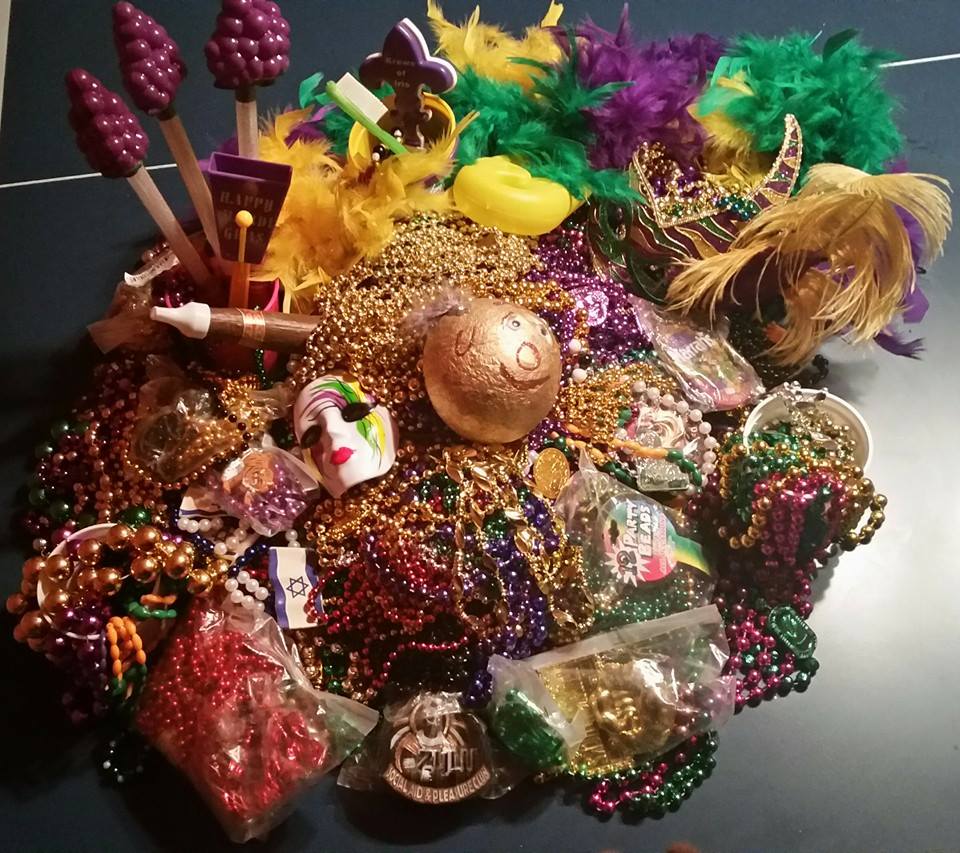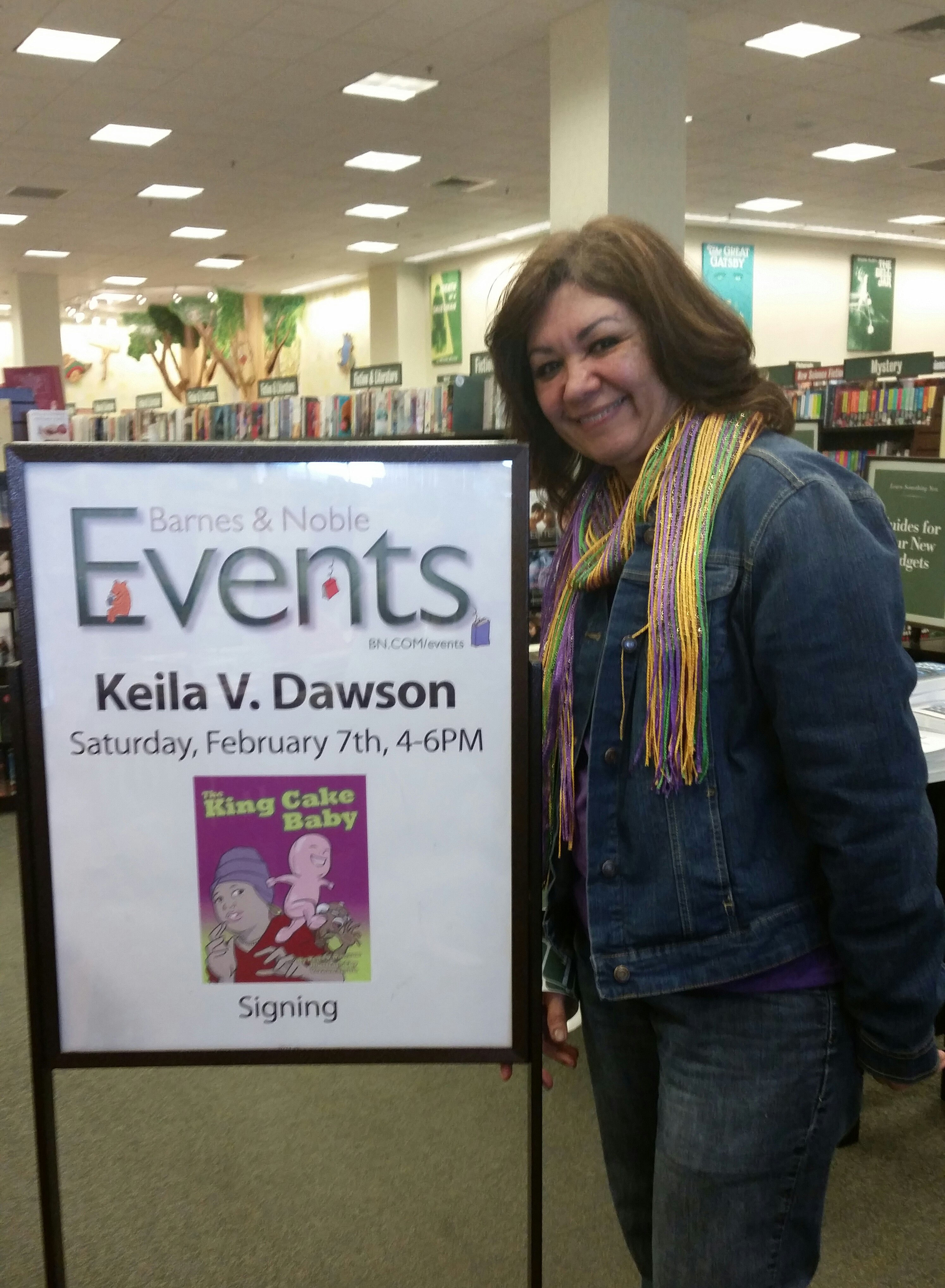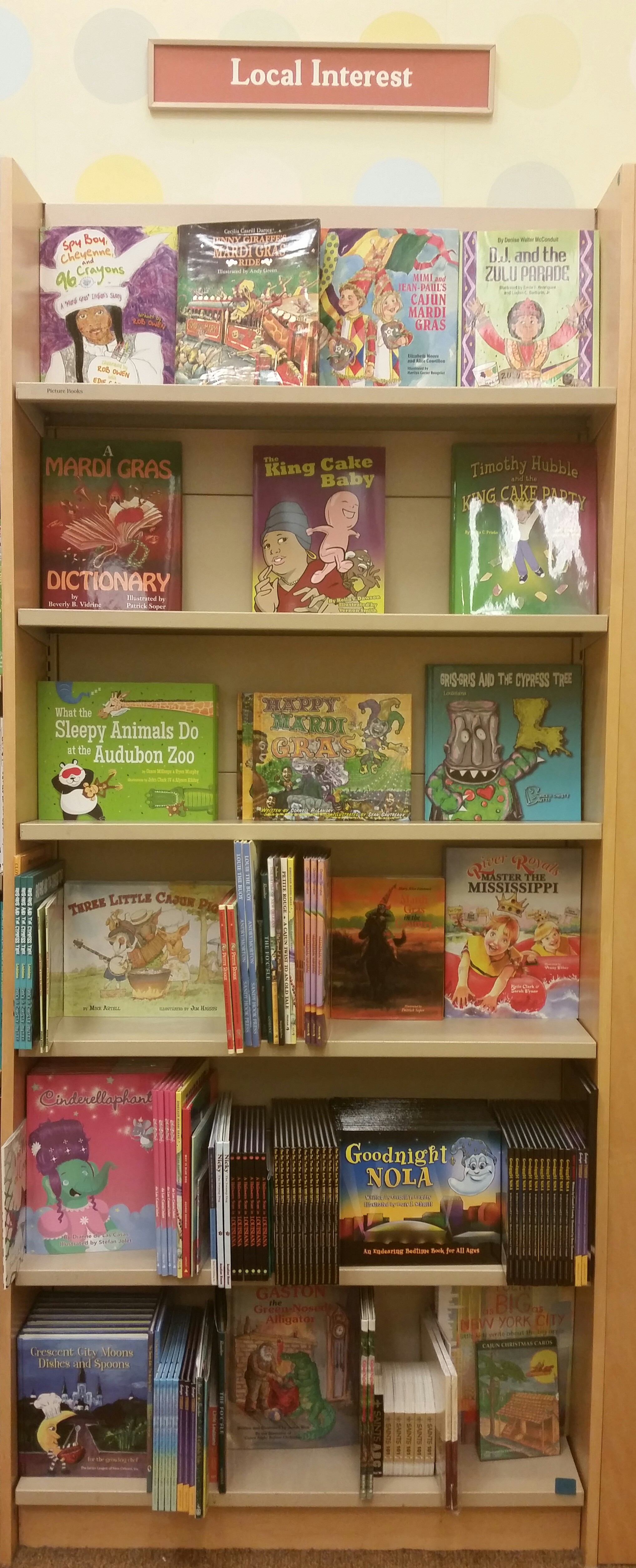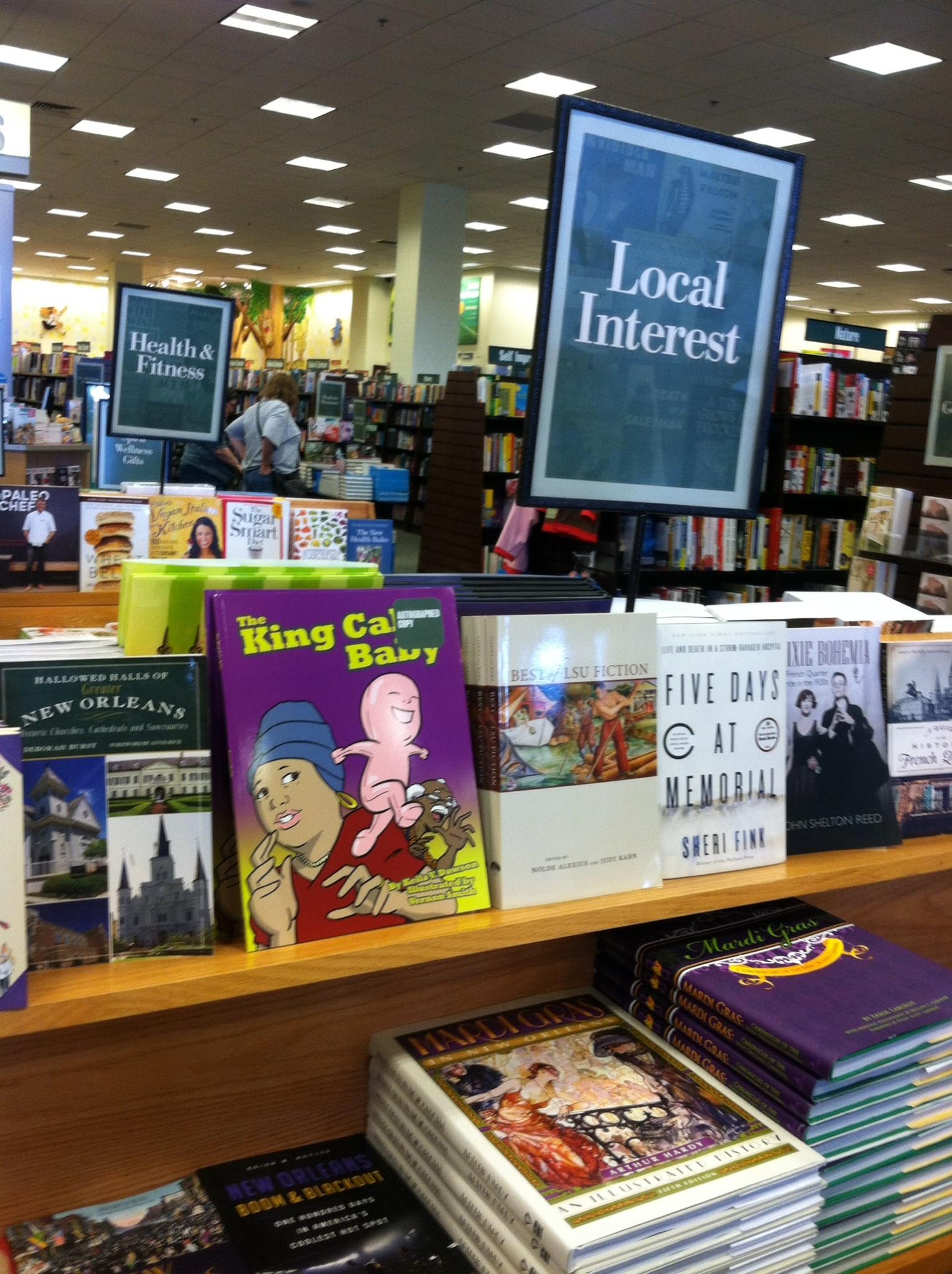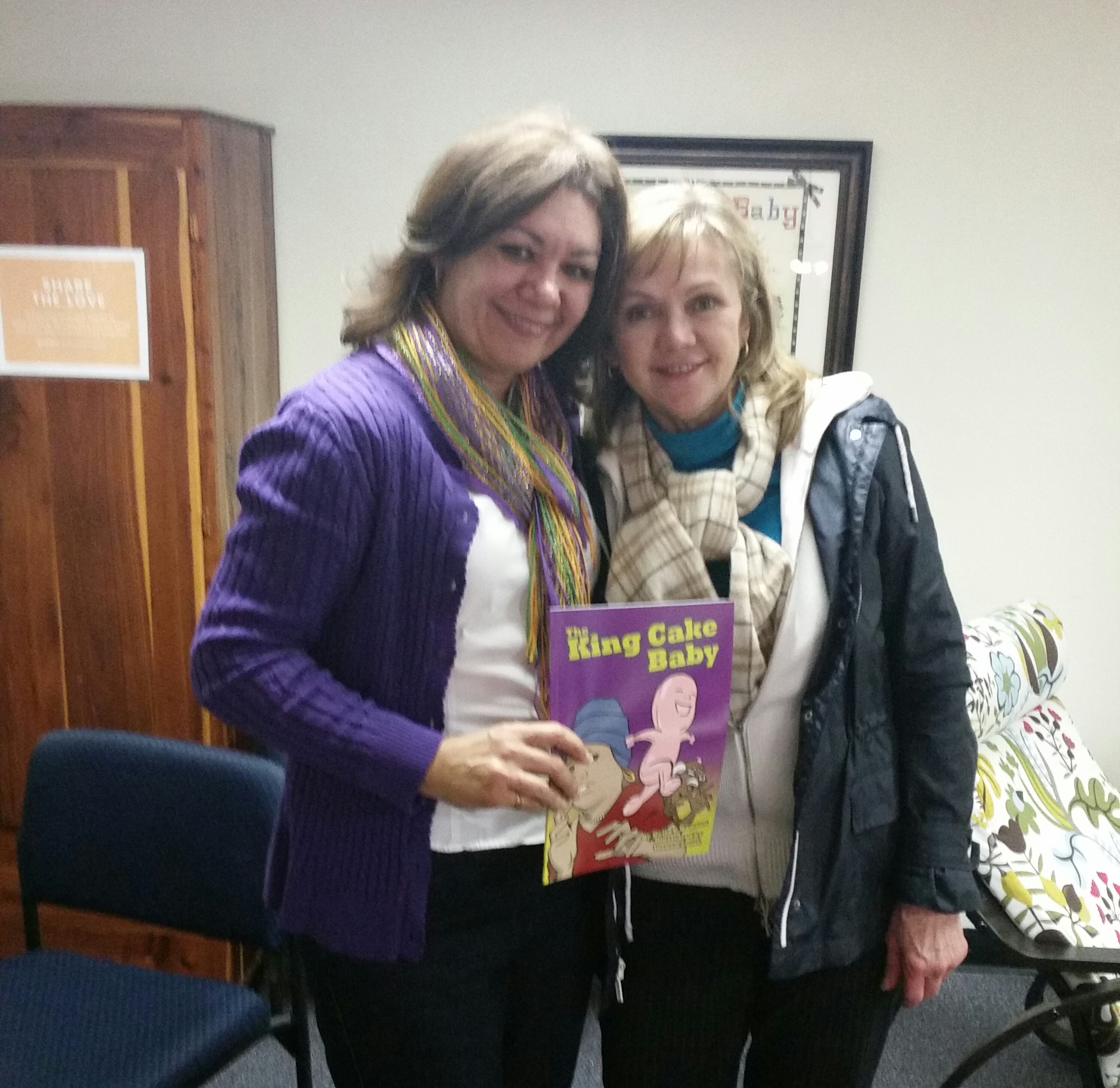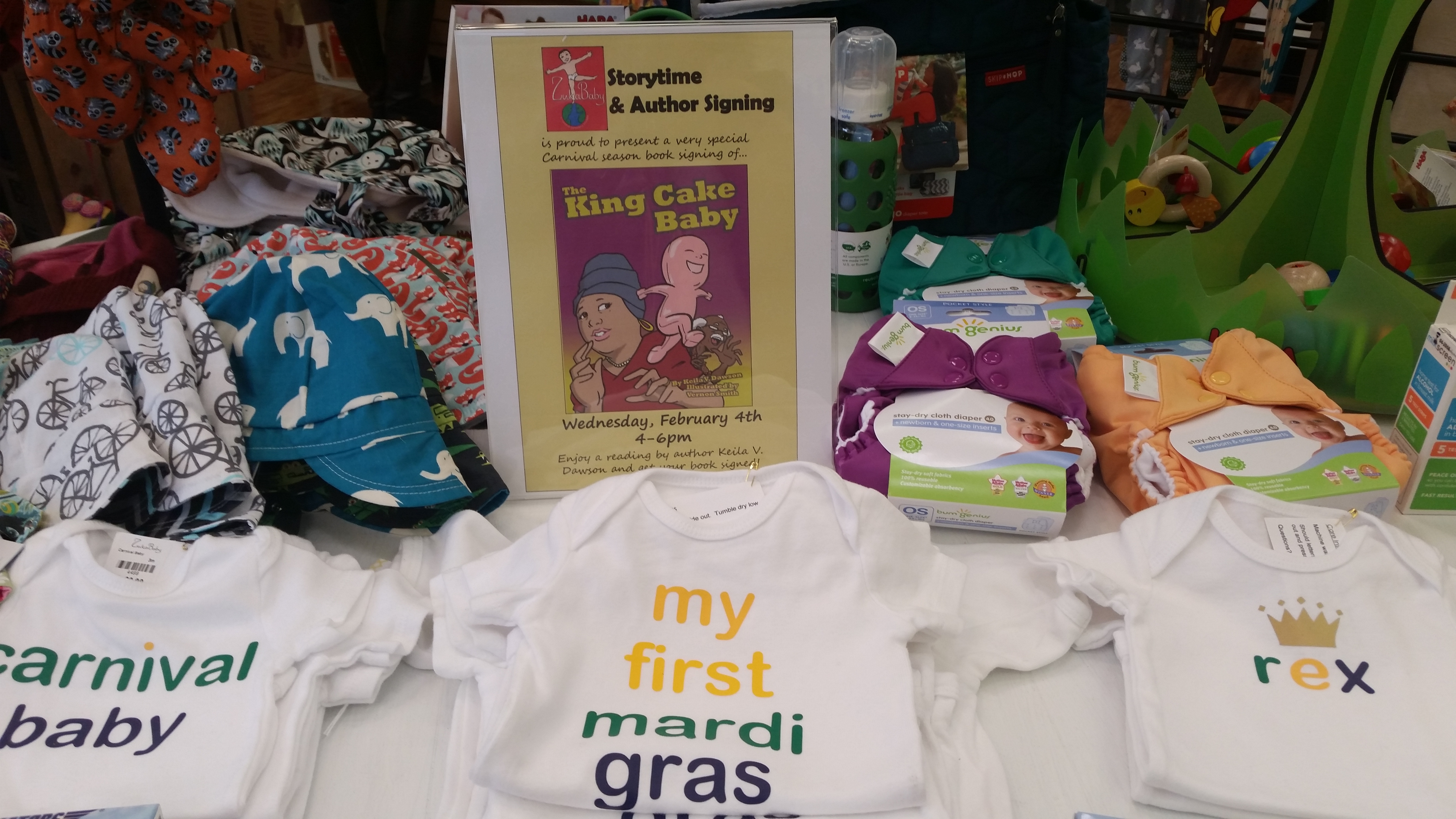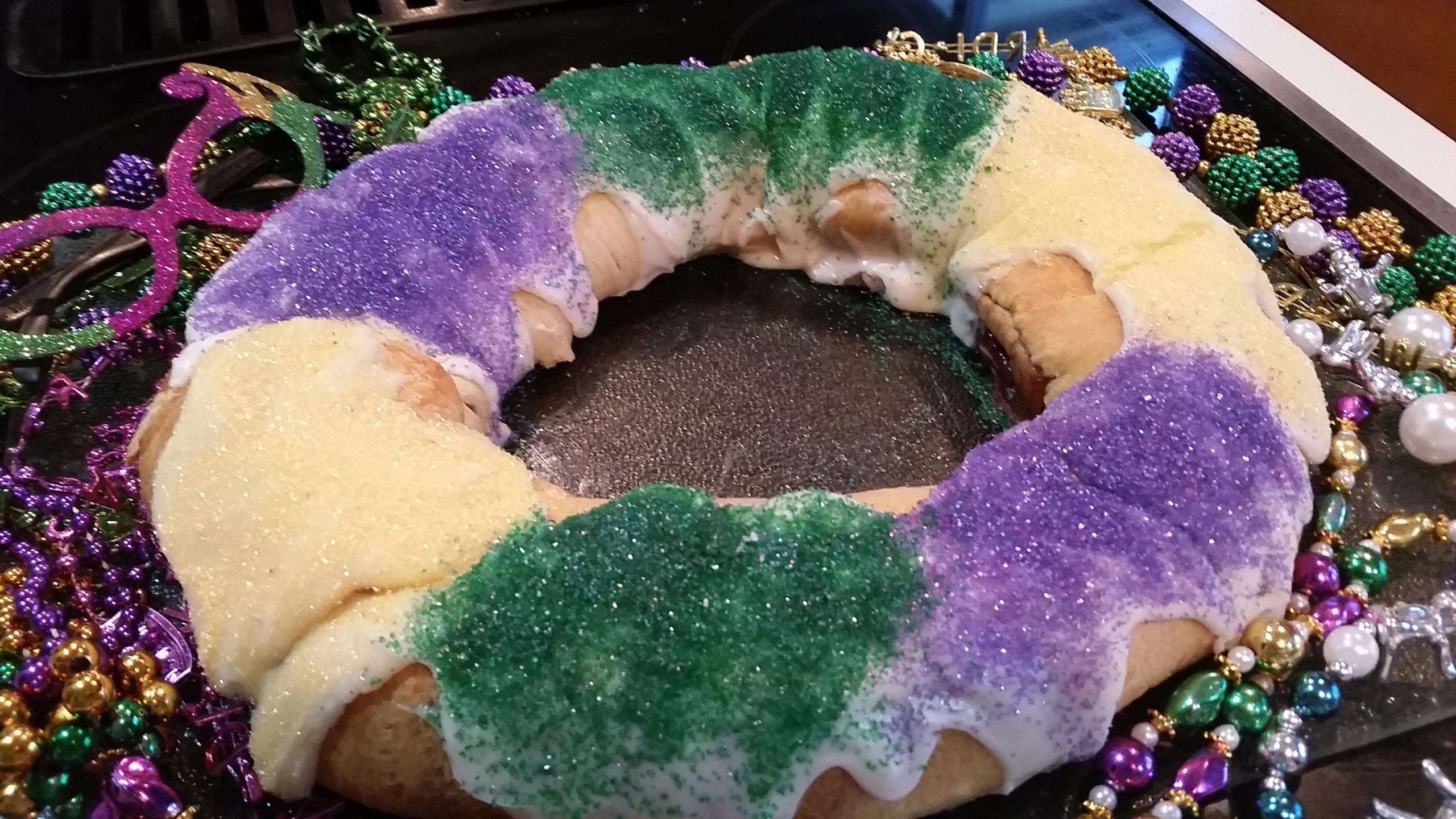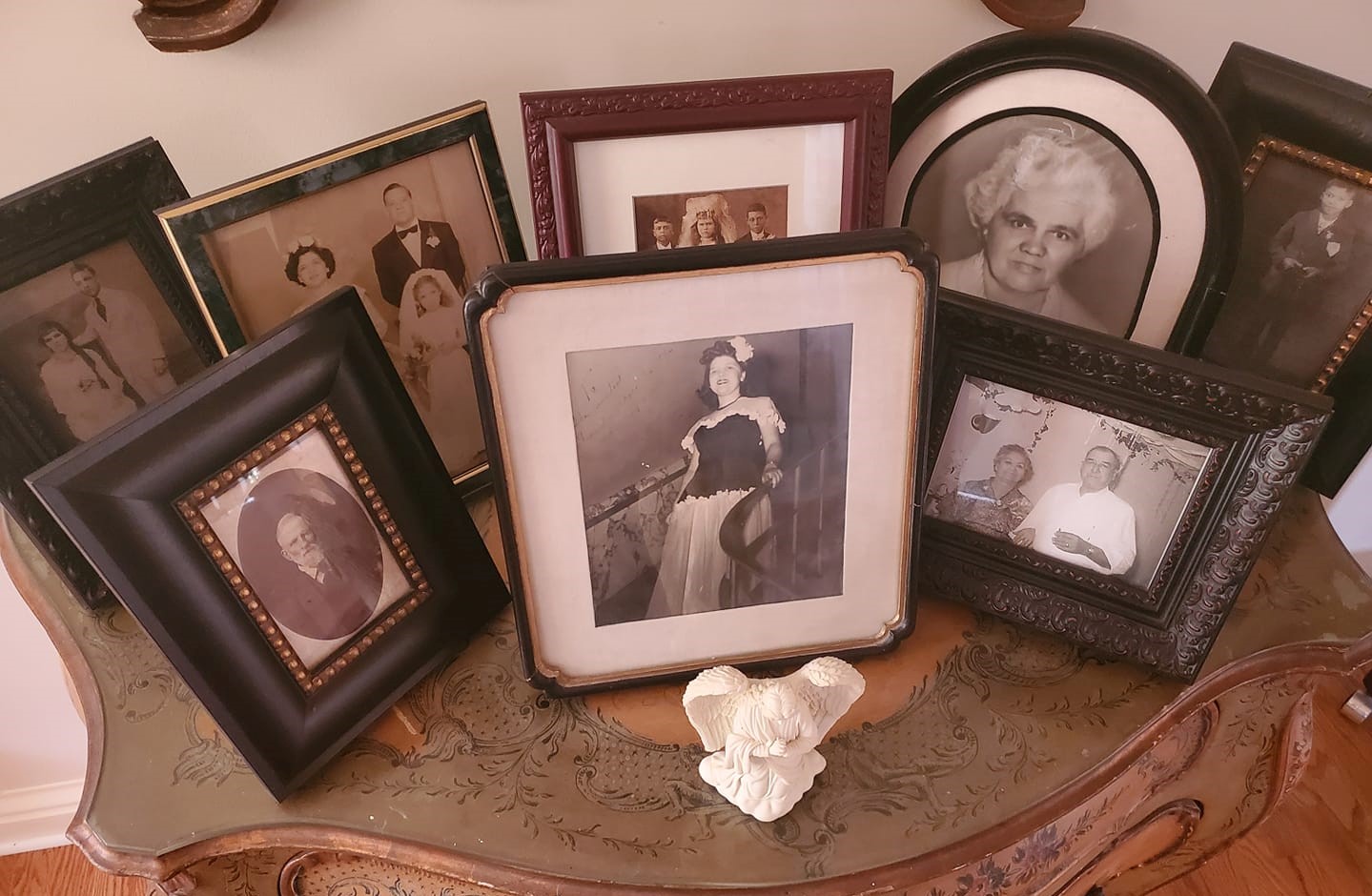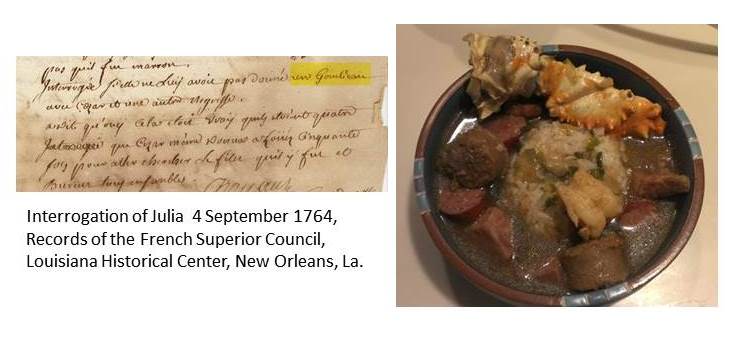Thanks to Video Production by Carrie Charley Brown!
Thanks to Cincinnati Public Library – Deer Park Branch for inviting me to share The King Cake Baby and the sights, sounds, and tastes of New Orleans on February 19, 2015.
Reading The King Cake Baby!
Making candy bracelets and necklaces
Masks!
Parade!
Beads!
He put the baby back in the box. The baby belongs in a king cake!
Thanks for having me at Carnival Story Time Blue Manatee! What a wonderful way to celebrate Mardi Gras day! I read The King Cake Baby, we listened to Mardi Gras music, had a parade, and ate king cake. Yes! Someone got the baby!!
I had a blast sharing the sights, sounds, and tastes of New Orleans!
Reading The King Cake Baby
Where is that Baby going? He’s running away!
Who will he meet? Who will get the baby? Who will catch him?
Parade! Music! Masks! And beads!
Raise your arms high, wave, and yell, “Throw me somethin’ mista!”
Great catch! Look at all those beads!
Made some new friends!
Grown up friends came to visit! And we had king cake!
And someone got the baby!
And autograhed books
Happy Mardi Gras!
Little Toy Shop, 900 Decatur St, New Orleans, LA 70116, French Quarter
Thanks for having me over for a Meet The Author event on a beautiful day in New Orleans!
How to catch Mardi Gras throws is a question asked by visitors every year. Is it an art? Is it a science? Catching “throws”, the beads, cups, toys, doubloons, and trinkets thrown from Mardi Gras floats is serious business. Can tourists learn to maximize their chances of returning from parades with a huge haul?
As we say in southern Louisiana, yes, indeed! Below are some tips for a successful trip.
Quick tips:
1. Comfortable clothing. Seems like a no-brainer, but yes, I’ve seen people in open toe shoes and heels. Clothes worn to the gym or yoga are great. Parades are no place for vanity, people! Keep your eye on the prize, catching free stuff!
2. Training & Exercise. Competing with locals who are obviously born with the ”catch” gene will take some preparation. Work on your vertical jump. Start a stretching routine. Flexibility is key. Improve your reflexes.
3. Anticipation. You have to be able to recognize when a float rider has targeted you for the throw or someone else. If the 3-year-old on his or her father’s or mother’s shoulders is the target, you have seconds to decide if you will snag that throw. However, if you do, I suggest you move to a new location.
3. Practice. Get in front of a mirror, raise your arms up high, wave furiously while jumping up and down and scream, “Throw me somethin’ mista’!” Acceptable alternatives include, “Hey, ova here!” or “Me! Me!” or “Here, here! Mistah’!” I’ve witnessed many falls. Can you say EMBARRASSING! Practice, practice, practice.
4. Visual attention. Never take your eye off a passing float! Let’s face it, some float riders have really poor aim. Use your peripheral vision to avoid elbows, arms, and crashing bodies. Ouch.
5. Competition. It’s important to size up those parade goers around you. Assess the number of parade ladders with seats. How many are nearby? Cute kids in costume. No explanation necessary. You think older people are no threat to a successful haul? See #2. For locals, it’s their natural habitat. Do not be deceived. Missed air born throws that reach the ground are their specialty. Do not try to pick them up. Feet are used to accommodate for their lack of upper arm mobility. Crushed fingers are no fun.
4. Science and more. Here’s where that high school physics class you thought you’d never need could be useful. Speed. Distance. Velocity. Mass. Are the beads small or large? Short or long? Single or in a full pack? With or without a medallion or some other attachment? Applicable to other trinkets and toys as well. Consider the type of toss. Underhand or overhand? Adult or child? Factor in the level of inebriation. How badly does the krewe member sway and lean? Inebriated float riders may throw a pack of beads intact. Muscle motor function may be impaired. In short, they have difficulty opening the plastic bags. Be brave. Be ready.
Good luck out there! And remember, if you may catch so many beads and trinkets that you’ll have to consider paying the airline overweight charge, or have to check an additional bag on your flight home, félicitations! Well done!
You did it! Be proud. Start planning a return trip. You know you can do better next year.
Happy Mardi Gras!
Maple Street Book Shop meet the author event. Thanks for having me, serving king cake and allowing me to read my debut book The King Cake Baby during story time! Visit them at 7529 Maple St, New Orleans, LA 70118.
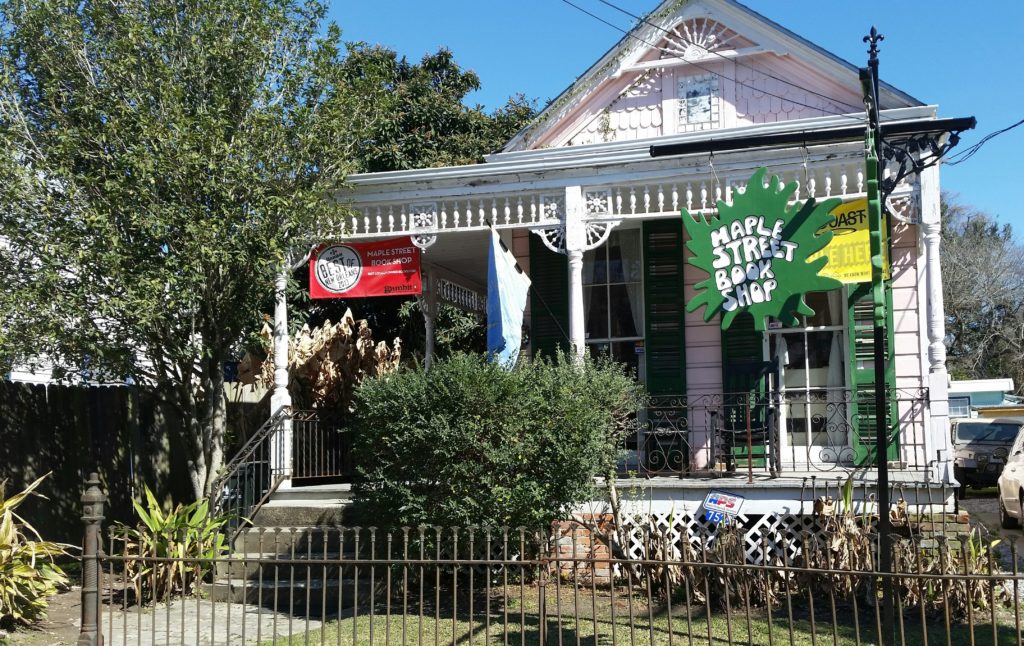
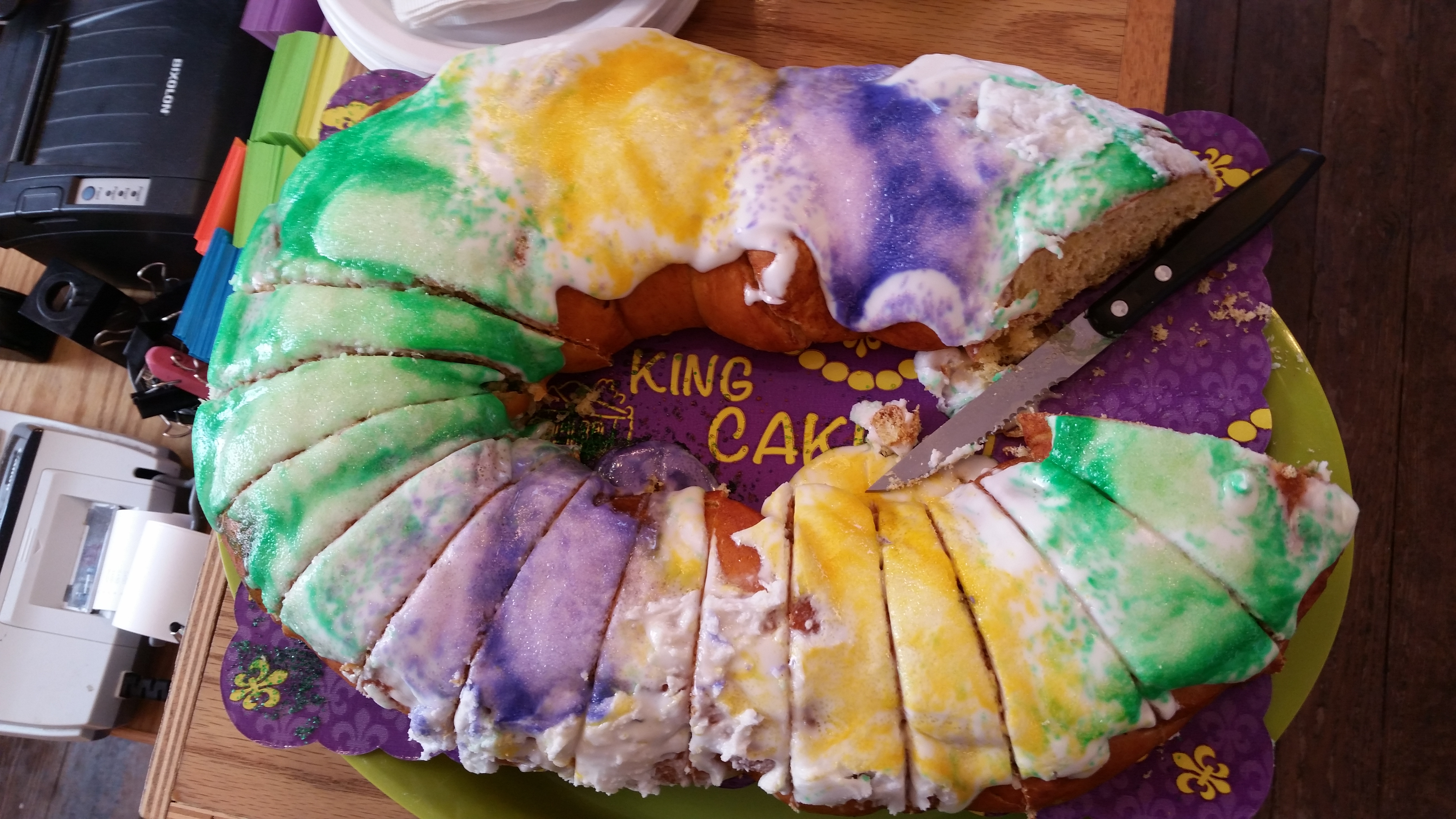
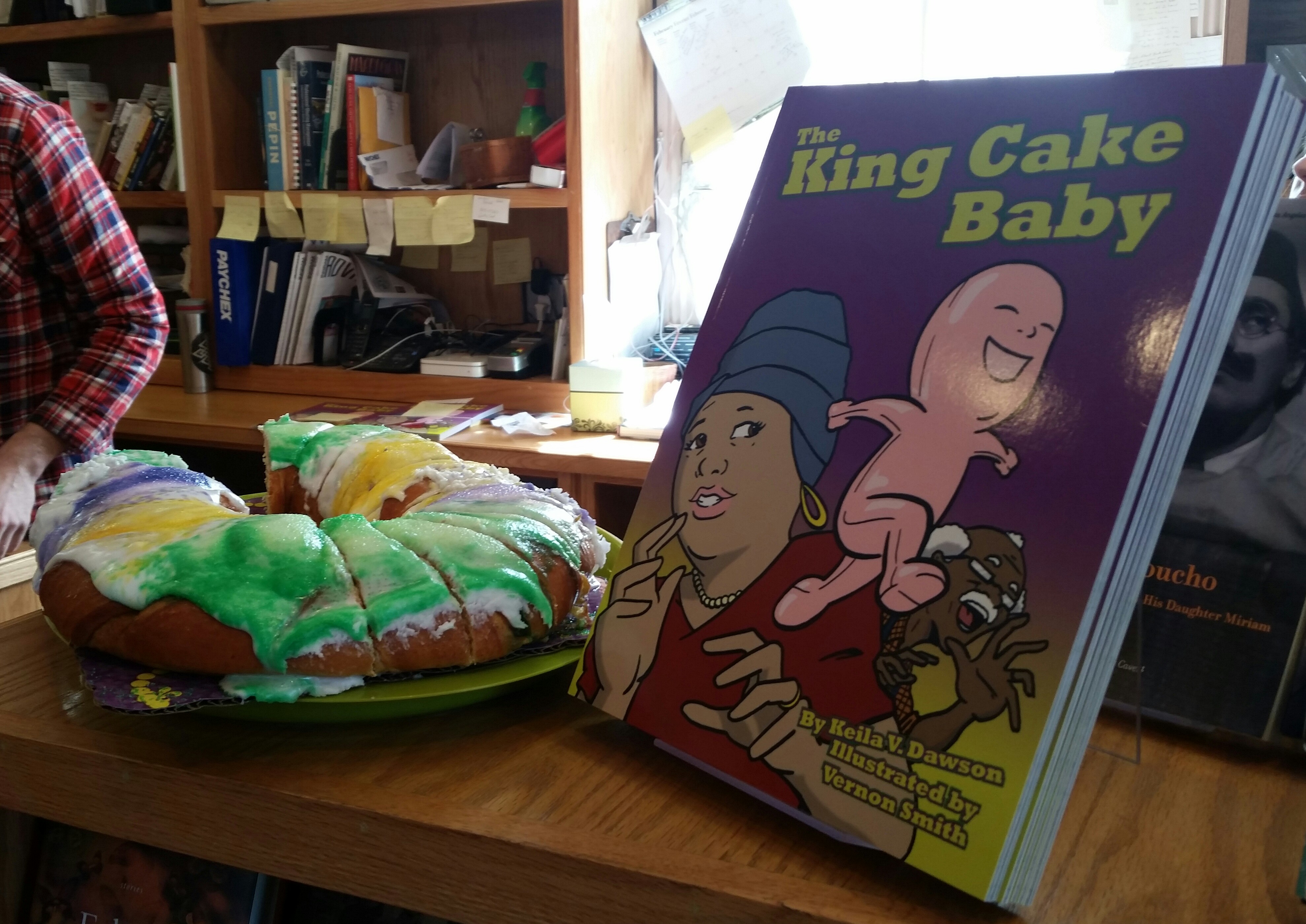
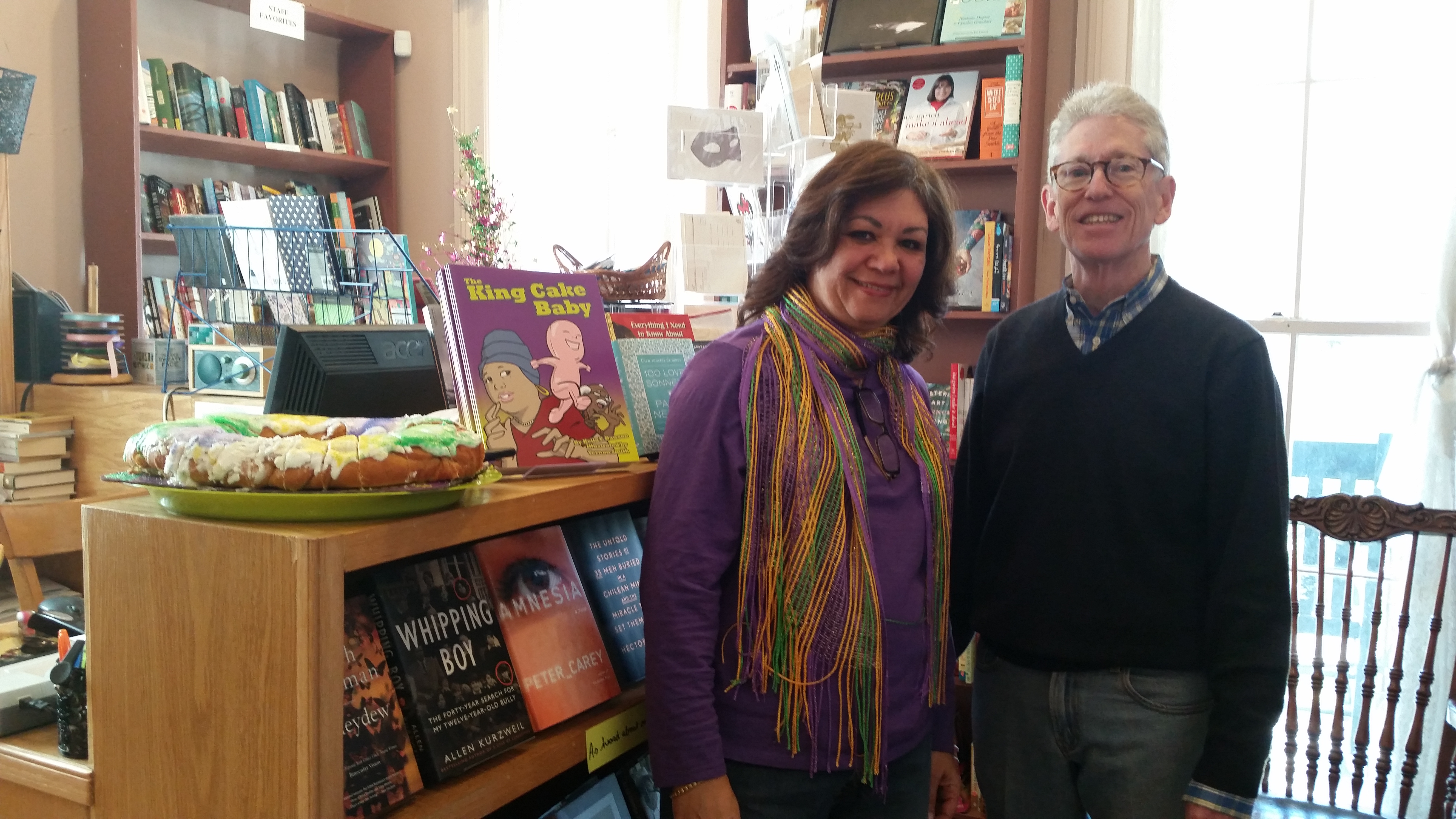
NOLA kids Meet the Author & Illustrator event. Thanks for having us! Visit them at 333 Chartres St, New Orleans, LA 70130.
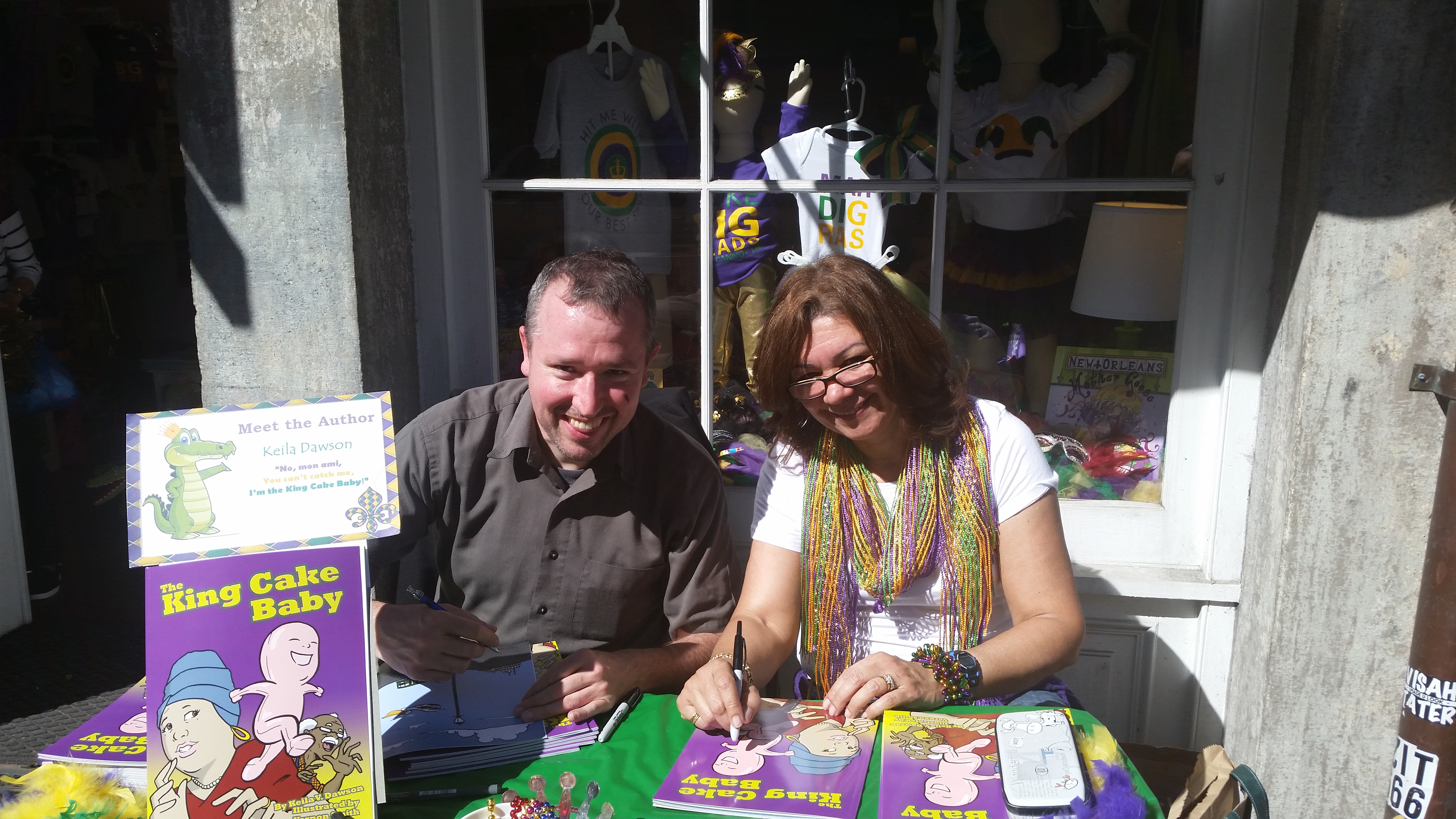
Vernon making his mark
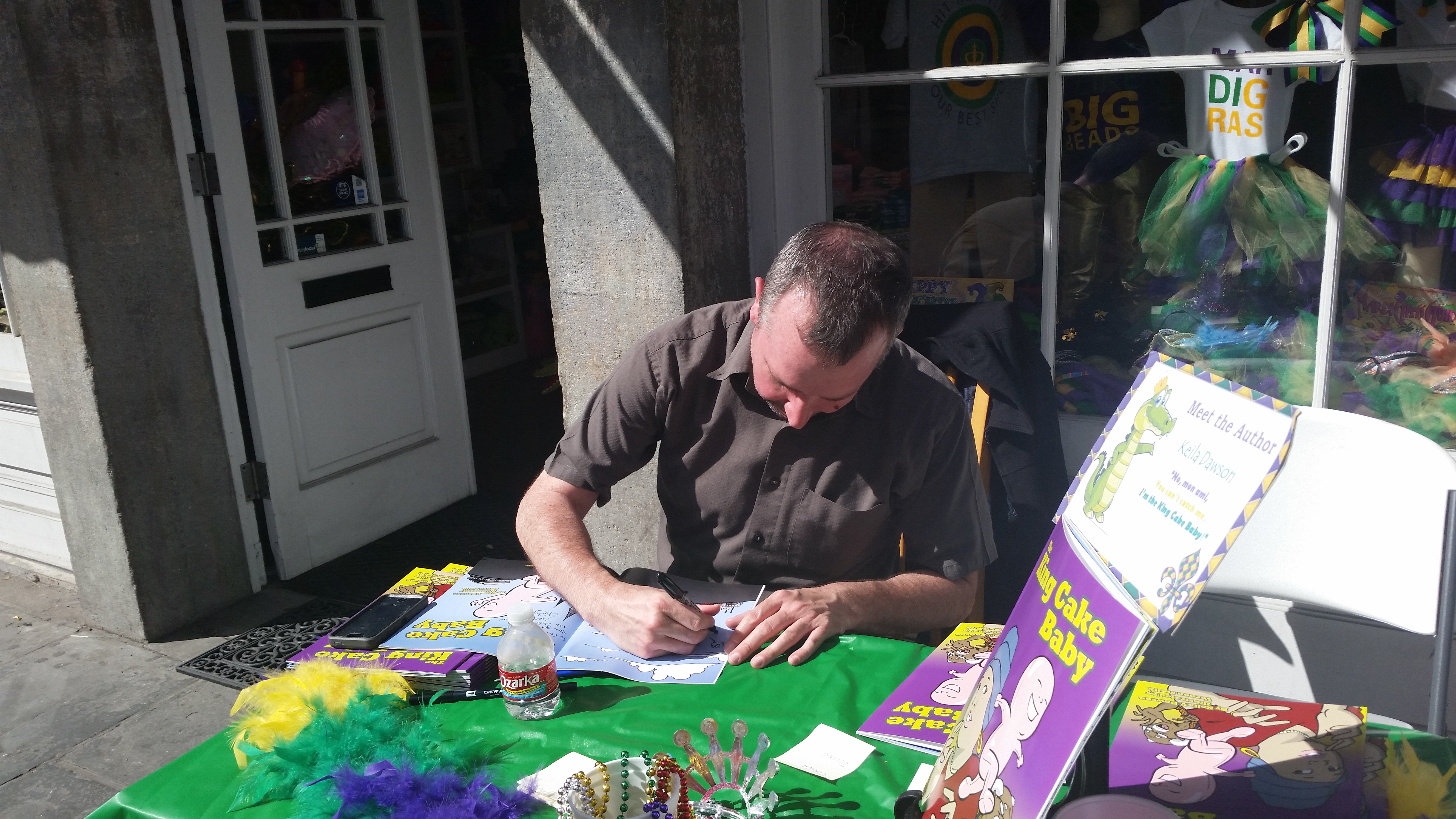

Krewe of Barkus rolling through the French Quarter
ZukaBaby Meet the Author & Illustrator Events at 2122 Magazine, Uptown and 3248 Severn Ave in Metairie.
Thanks for having us, and allowing me to read my debut book The King Cake Baby during story time!
Our baby! Carla, a friend from high school came!
Woodland West Elementary, Harvey, Louisiana, Friday, Februray 6, 2015
Thanks to the teachers, staff, and students at Woodland West Elementary, I had a wonderful visit!





International School of Louisiana , Friday, February 6, 2015
Such a wonderful visit with ISL! Thanks to Laurence Copel, the resource librarian at ISL, I had a wonderful visit!


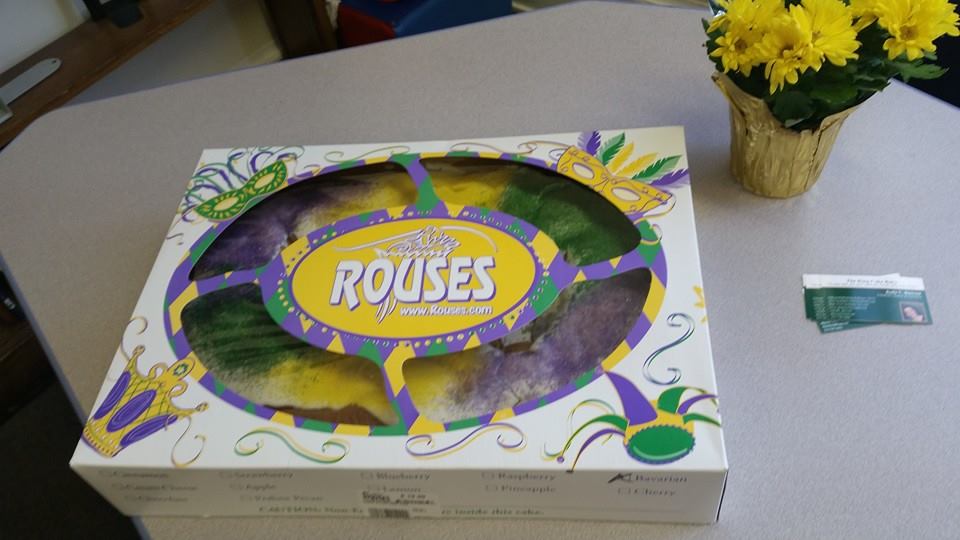
King cake, Mardi Gras, parades, krewes – all traditions unique to New Orleans and Louisiana culture here in the US.
Everyone in Louisiana knows what day it is! It’s Kings’ Day, January 6th, the first day of the Carnival Season!
When people learn I am from New Orleans, they often ask about our Carnival or Mardi Gras traditions. I always include a bit of history about king cake and the tiny plastic baby that is hidden inside. The idea for my upcoming debut picture book, The King Cake Baby, came to me while making a king cake. I couldn’t find a baby and panic ensued. If you don’t have a king cake baby to hide inside, the pastry is just a cinnamon roll!
And I was listening to New Orleans music. So first, here’s a song. Sing along!
Eh là bas! Eh là bas! [Hey over there! Hey over there!]
Eh là bas chérie! [Hey over there, dear.]
Komen ça va? [How’s it going?]
(New Orleans musician Don Vappie on banjo and vocal)
Read on if you’d like to learn more about our traditions. The history of our Carnival and Louisiana king cake practices stem from the periods of colonization as well as English tradition. Combining cake customs from the French and Spanish rulers created the foundation for this Louisiana Creole tradition celebrated on the last day of Christmas also known as Little Christmas, Feast of the Epiphany or Twelfth Night. The beginning of Carnival is always on January 6th and is also known as Kings’ Day. King cakes are baked and eaten throughout this time, known as the pre-Lenten season. Carnival or “carne vale,” means “farewell to the flesh”. Mardi Gras or Fat Tuesday, the day before Lent, is the last day of Carnival. In 2015, Mardi Gras Day is February 17th. Although always a Tuesday, the date varies, therefore the length of the season does too. The number of days during Carnival depends on the liturgical calendar of the Catholic Church. It’s the time between Twelfth Night (in New Orleans, that’s between January 6th and the first day of Lent, Ash Wednesday.) Actually, the date for Easter Sunday sets the length of the Mardi Gras season.
Carnival is celebrated all over the world. And cakes are made too. In France & Québec the cake is called La galette de rois, in Spain and places they colonized like Mexico, South America, Florida, and California the cake is called Rosca de Reyes or ring of kings, in Germany its Dreikonigskuchen, in Scotland, the Black Bun, in Portugal, Bola-Rei. And many more I did not mention. In Louisiana, king cake is a symbol associated with the spirit of Carnival.
Many are surprised to hear that Carnival was not always a mass public daytime celebration in New Orleans. The first Mardi Gras parades were organized in Mobile, Alabama! In 1837, when the people of New Orleans started publicly celebrating in the streets, they were so wild that the government almost banned these celebrations. Yikes! By 1856, the private club or ”krewe” named the Mistick Krewe of Comus from Mobile came to New Orleans to save Mardi Gras. They organized a festive and safe event with floats, masked members who paraded in the street wearing costumes, and hosted masquerade balls .
Credit for the merriment of Mardi Gras seen today in New Orleans goes to the Krewe of Rex dating back to 1872. When Russia’s Grand Duke Alexis Romanoff visited New Orleans, the Krewe of Rex arranged a daytime parade. In 1875 Mardi Gras became a legal state holiday. Decade after decade the celebration grew. More krewes started, bands and throws like beads and doubloons were added to the parades. With the addition of larger krewes and celebrity participation Mardi Gras in New Orleans became an international event.
Louisiana “king cake”, known as kings’ cake or three kings cake in Europe and Latin America, takes its name from Catholic liturgical tradition commemorated on January 6th that celebrates the visit of the Wise Men or three kings to visit the Baby Jesus. The Twelfth Night Revelers, a Carnival society from 1870 chose the “Lord of Misrule” as their king at their ball, following old English tradition. The following year they started the tradition of choosing a queen for his majesty on January 6th. Today that tradition continues, using a “mock” king cake, and the event is considered a kick-off to the Carnival season. King cake eventually became a symbol for the start of the Mardi Gras among locals who were not members of these grand societies. The Krewe of Rex chose the colors associated with Mardi Gras today; purple for justice, green for faith, and gold for power also used to decorate king cakes. In the French tradition, originally a bean or la fève, was hidden inside a king cake. Early on Spain used figurines to represent the Baby Jesus. In Louisiana, pecans and even jewelry were used. However it wasn’t until the 1940’s, that a beloved New Orleans bakery, McKenzie’s, started using the plastic baby we see hidden in king cakes today. In Catholic tradition, the baby represents the Baby Jesus. Whoever gets the baby or whatever is hidden inside is supposed to bring the next king cake or host the next king cake party or could be “crowned” king or queen.
Retail stores love Christmas, florists love Valentine’s Day, chocolatiers love Easter, and Louisiana bakeries love the king cake season! By 1950, the public began buying lots of king cakes. Today, thousands of cakes are eaten and shipped around the world during the Louisiana Mardi Gras season.
And now New Orleans hosts its very own King Cake Festival! The second annual King Cake Festival scheduled for January 25, 2015 is sure to be fun!
Starting today, EAT. KING. CAKE. if you are in New Orleans, join the festival. Plan a trip to see a Mardi Gras parade. Just don’t forget the baby mon ami!
Today, November 2, is All Souls Day. It is a day of prayer for the dead, particularly but not exclusively, our relatives. Whereas, yesterday, All Saints’ Day, the Catholic church asks followers to live as saints did, on All Souls’ Day we honor and ask for mercy for our ancestors and the souls departed from this world as we know it.
Yesterday, on All Saint’s Day, the family back home cleaned our family tombs in cemeteries around the city, some so old they were built when la Louisiane was still a colony. Today, on All Souls’ Day we honor our dead because we believe their souls and spirits live on even when the body dies. To us death is not creepy or scary, it’s a part of life. In a way, we keep our dead alive, the lines a little blurry. Our ancestors live on in those left behind in their families and communities. Those are our customs and traditions and in our culture, that’s the way we roll.
I lost two elders recently, a 5th cousin and my mother. Today they are in my thoughts and heart as are all the family departed I was fortunate to know in their lifetimes. As our family historian, I also honor our ancestors whose stories I have uncovered, buried in documents and dusty archives. Prayers up mama, love and miss you dearly. Tell everyone I said hello.
ECCLESIASTICUS 44TH CHAPTER, VERSES 1-10 AND VERSES 13-14.
Let us now sing the praises of famous men, our ancestors in their generations. The Lord apportioned to them great glory, his majesty from the beginning. There were those who ruled in their kingdoms, and made a name for themselves by their valor; those who gave counsel because they were intelligent; those who spoke in prophetic oracles; those who led the people by their counsels and by their knowledge of the people’s lore; they were wise in their words of instruction; those who composed musical tunes, or put verses in writing; rich men endowed with resources, living peacefully in their homes-all these were honored in their generations, and were the pride of their times. Some of them have left behind a name, so that others declare their praise. But of others there is no memory; they have perished as though they had never existed; they have become as though they had never been born, they and their children after them. But these also were godly men, whose righteous deeds have not been forgotten. Their offspring will continue forever, and their glory will never be blotted out. Their bodies are buried in peace, but their name lives on generation after generation.
It’s National Gumbo Day!
And all Louisianans know nothing stirs the emotions like a discussion about food. But we all know the answers to the questions often asked by visitors to New Orleans, “Who makes the best gumbo in the city?” The typical reply is, “My mama.” Or “Where do I go to eat the best gumbo in the city?” That answer is, “My kitchen.” Because our mamas taught us to make our gumbos.
So what’s all the fuss about? Firstly, Gumbo is the official cuisine of Louisiana. Easy to understand why any origins to the dish would then elevate a group to a special status. However the name of the dish itself is a perfect analogy to the culture of Louisiana, it’s a mixed pot.
The first reference to ”gombeau” in New Orleans was in 1764 discovered by Louisiana colonial historian Gwendolyn Midlo Hall. It’s a record of testimony written in French and archived in the records of the French Superior Council. Of course this does not mean others who lived in the territory before 1764 were not making the dish, but often the reference to 1802 as the first record of gumbo is incorrect. In 1764 we know where in the world people came from who lived in the colony and who they found living there upon arrival. We know the Choctaw, an indigenous Louisiana people thickened soups using filé, still used today to thicken many gumbos and some believe used the term ‘kombo-lichi’ to refer to such dishes. We know ki ngombo is the Bantu word for okra, another staple used in some gumbos. And today, we know a good gumbo requires a roux, a mixture of flour and a fat like butter, used in classical French cooking as a thickening agent. But these facts still don’t answer the question about the origin of the dish. Maybe that’s a good thing because like all those ingredients put in a gumbo pot, what comes out is something special and unique. Just like me and everyone out there with Louisiana roots.
Happy Sunday Gumbo Day!
What do you need in the most festive city in the USA? Another festival! The 1st Annual King Cake Festival coming this February. It’s a family friendly festival too. Live performances, kid’s games, stroller fun run and of course a King Cake competition. And it’s FREE.
Wish I could be there with y’all. Have fun! Eat King Cake. AND DON’T FORGET THE BABY! http://www.ochsner.org/king-cake-festival/

